Ep 103: What’s Michael? by Makoto Kobayashi + Garfield + Heathcliff
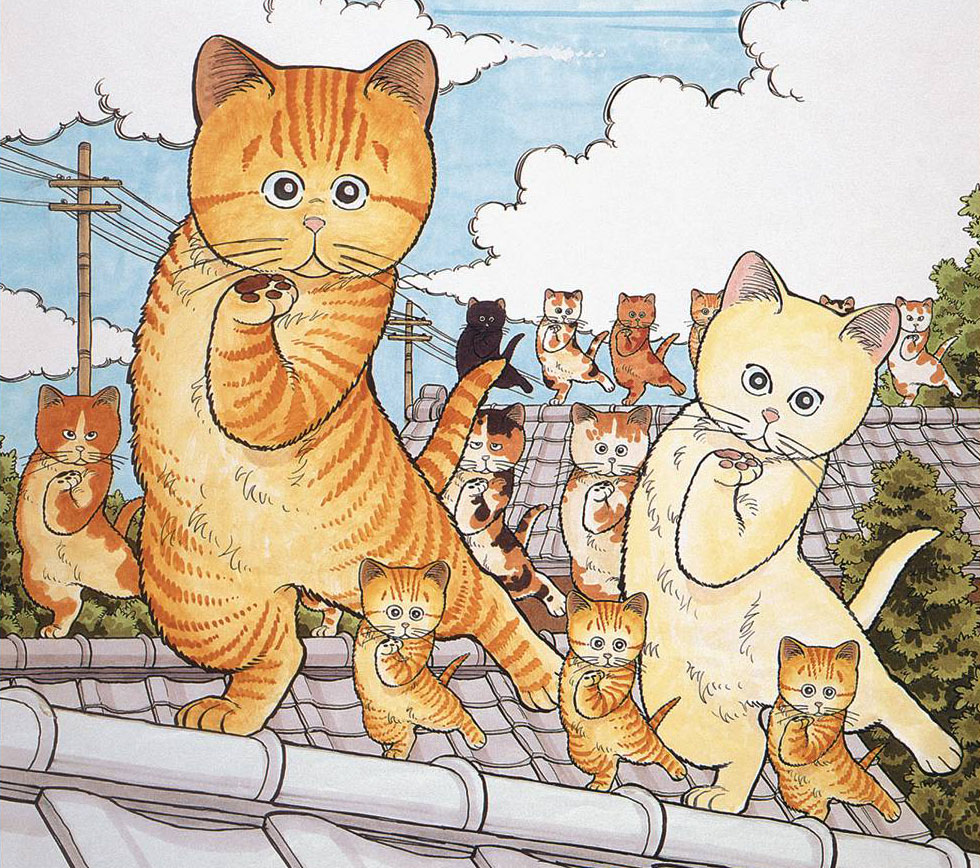
Chip did it, he called our bluff! So in this episode, we’re discussing the funny orange comic book cat phenomenon, centering on Japan’s entry into that particular sweepstakes, Makoto Kobayashi’s What’s Michael? But don’t worry, we also talk about those other orange tabbies, Jim Davis’ Garfield and George Gately’s Heathcliff, too. Plus, a very complicated mailbag question from comic writer extraordinaire, Matt Fraction. It’s a weird one folks, strap in.
Powered by RedCircle
Listen and Subscribe to the Podcast:
Google | Apple | Stitcher | RedCircle | Amazon | Radio Public | PocketCast | Spotify
IN THIS EPISODE
00:00 What’s Michael: Fatcat Collection Volume 1
44:28 Let’s add some Heathcliff and Garfield into the mix
01:00:00 THE BREAK
01:00:00 Q&A: Matt Fraction asks about Hayao Miyazaki’s Porco Rosso comics
Also, if you haven’t checked it out lately, we’ve been creating a ton of great work over on the Mangasplaining Extra Newsletter including weekly serializations of TWO new manga series, why not go check it out?
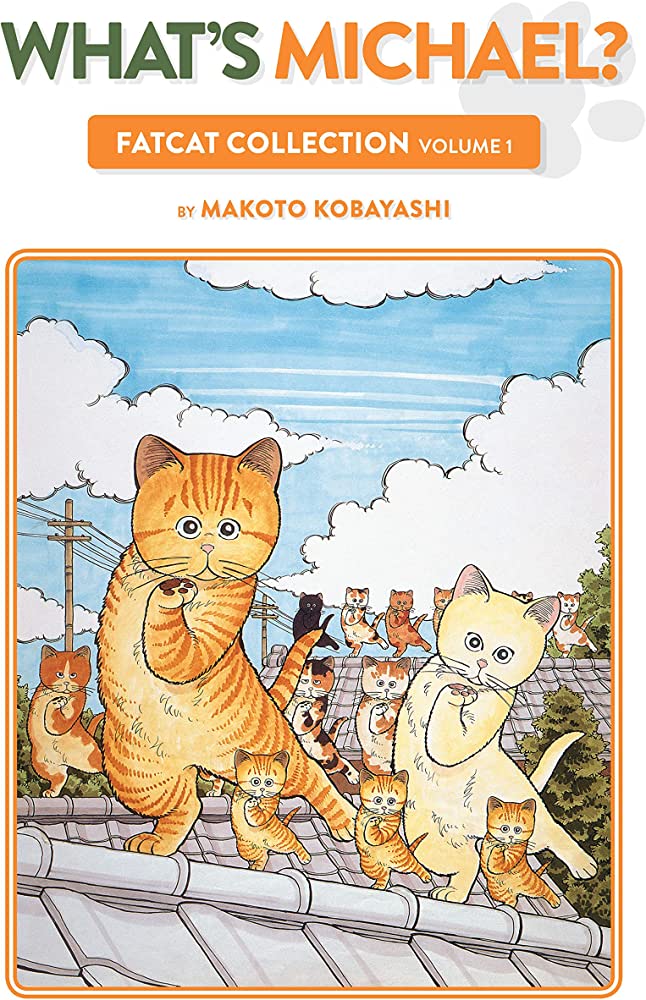
What’s Michael: Fatcat Collection Volume 1
By Makoto Kobayashi
Translated by: Alan Gleason, Hisashi Kotobuki, Dana Lewis, Lea Seidman, Toren Smith, and Elin Winkler.
Lettering and retrouch by: L. Lois Buhalis, Amador Cisneros, Pat Duke & Radio Comix, Tom Orzechowski, and Amy Stella
Published by Dark Horse Comics (Print Only)
Audio editing by David Brothers. Show notes by Christopher Woodrow-Butcher and Deb Aoki

ABOUT MAKOTO KOBAYASHI
Makoto Kobayashi has one of the nicest and most informative websites I’ve ever seen for a manga creator, and so rather than writing up a bio I’ll just copy it from his website, after being run through Google Translate and then cleaned up a bit:
Makoto Kobayashi was born on May 13, 1958 in Tsukifune-cho, Niigata City. In 1964, when he was 6 years old, he was affected by the Niigata earthquake. His house was partially destroyed and submerged in water due to liquefaction. After living in a shelter for a long time, he moved to Kurosaki Village, Nishikanbara District (at that time). However, the house was next to the route for the proposed Joetsu Shinkansen route, and in 1973 they were evicted.
Kobayashi then moved to Taihei-cho, Niigata City. When he was in the third grade, he admired the manga Star of the Giants, and was inspired to begin drawing manga of his own with paper and pencil. His first story was [the similarly named] “Hanshin no Hoshi.” By the time he was in the 6th grade, he had created boxes full of sketches, screenplays, and manga storyboards, and was seriously drawing a work of around 40 pages using drafting ink on professional Kent paper.
In 1977, after graduating from high school, he moved to Tokyo. He became a disciple of the manga creator Mikiya Mochizuki (1938-2016). [Ed. Note: Mochizuki is best known in English as the creator of Wilf 7, a motorcycle manga published by ComicsOne but now OOP]
After that, he changed part-time jobs six times, and the following year, in May 1978, he made his debut as a manga artist by winning the Shonen Magazine Newcomer Manga Award.
“Since then, I have met many different people and reached my current position.”
Kobayashi has a bunch of other info on that page, including the answers to a few scandalous questions, and a separate bio for his work as a bass player and professional musician, plus links and images from most (all?) of his manga. His bio gives the sense of an old-school manga creator: hard-smoking, hard-living, blasting Jazz on his home stereo and spending a lot of free time in hostess clubs. He’s an interesting character. Alhough now in his 60s, perhaps he has settled down a little bit? He also has a Facebook page! And not like a fan page either, an actual Facebook page that he has made public. Wild. His self-portrait is charming too.
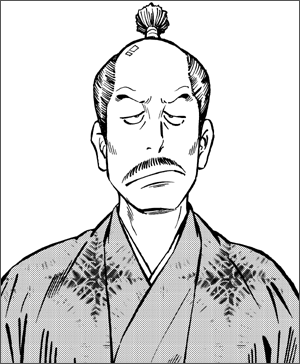
Interestingly, Wikipedia offers up some additional info: In addition to Star of the Giants he was also a big fan of Kazuo Umezu’s girls’ horror manga in his young life. His first award was actually for one of his manga submitted to the shojo magazine Ribon! He joined the judo club in high-school, and it influenced a lot of his later manga including Three Fighting Brothers, Judo Club Monogatari [story], and his current serialization, JJM Women’s Judo Club Story, currently sitting at more than 15 volumes. In fact he’s had more than a dozen series and a bunch of one-shots too. He’s a prolific creator.
What’s Michael is probably his most popular work, within Japan and internationally. While the original run lasted from 1984-1989, he did draw more adventures of his cat comics later. In 2001, he created another volume’s worth of What’s Michael stories when he released volume 9 in 2001. The series won the 10th Kodansha Manga Award for general audiences manga, sharing that award with Tezuka’s Message to Adolf all the way back in 1986. What’s Michael was also was adapted into two anime OVAs, and a 45-episode anime TV series too.
Interestingly, because the Dark Horse’s volume numbering doesn’t quite line up with the Japanese, it’s impossible to tell if the entirety of What’s Michael? has actually been released in English or not. I don’t think it has, as the 9th volume in Japan was released after the English serialization. I wonder just how much is left untranslated? Someone who’s deeper into this series might know. Hmm. Maybe one day we actually COULD get a What’s Michael Fatcat Collection Volume 3, with all new material? Dare to dream, Mangasplainers.
01:15 What’s Michael HAS been around for a while.
What’s Michael, being one of the early manga published in English, has gone through a lot of different formats over the years. The series was originally translated and published by Eclipse Comics, who produced two trade paperbacks(!) back in 1990.
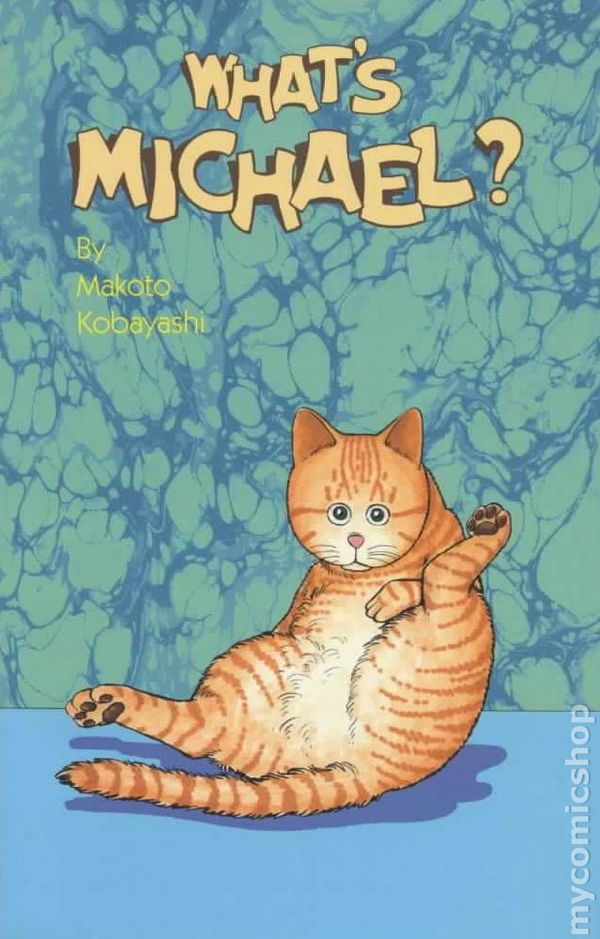
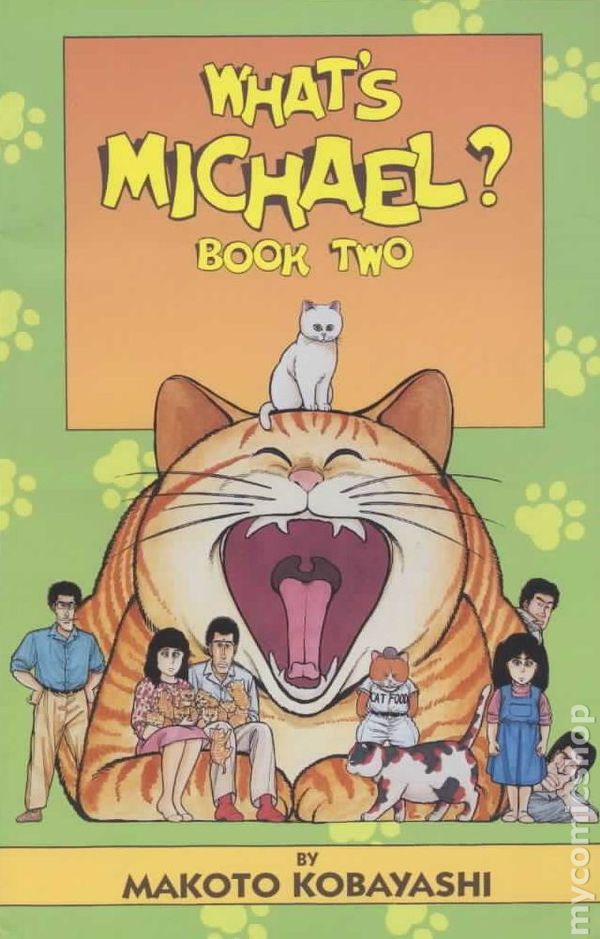
These materials were then re-released as graphic novels by Dark Horse. I think these two volumes are the Dana Lewis & Toren Smith and L. Lois Buhalis material that we really dug early in the book, reprinted more-or-less exactly.
Dark Horse picked up the torch by releasing new What’s Michael? stories in their anthology magazine that David mentions, Super Manga Blast.
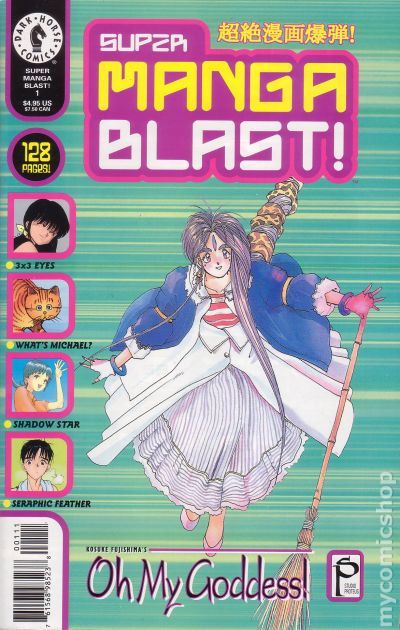
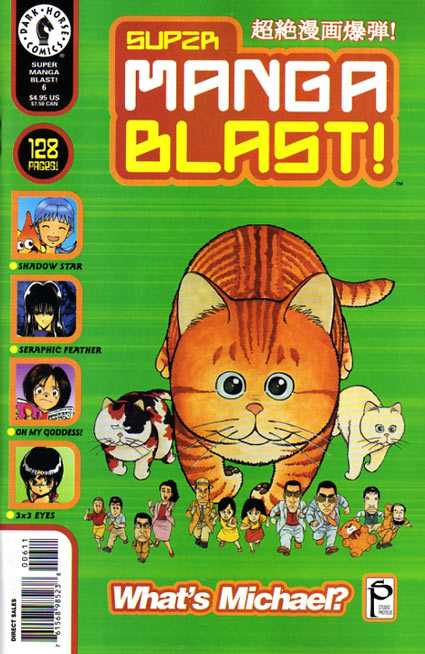
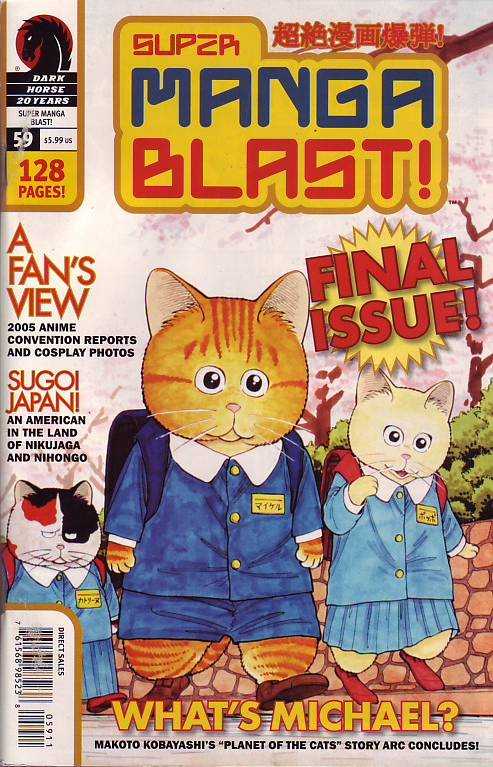
Super Manga Blast ran for 59 issues, was almost always 128 pages, and featured 3 or so What’s Michael? stories each issue. At the time, Super Manga Blast was probably the closest thing to a seinen manga anthology magazine, with its eclectic mix of sci-fi, humor and fantasy stories. SF and fantasy-themed stories were pretty the majority of manga stories published in English in North America then. Mind you, this was before Tokyopop, and then VIZ Media’s Shonen Jump magazine, completely changed the game.
What’s Michael? was also released in these austerely-designed trade paperback editions, offered as slim volumes with low price-points meant to compete (or beat!) TokyoPop’s manga releases, which were a smaller trim size, not flopped, and therefore, several dollars cheaper than most of Dark Horse’s and VIZ’s releases at the time.
But despite all these good intentions, this simply didn’t work, or at least it presumably didn’t sell well enough to continue for the long haul. The last issue of Super Manga Blast was published in 2006 and the graphic novel collections of What’s Michael? eventually went out of print, only finding an audience in English thanks to the popularity of the old strips finding their way onto the internet. Cat manga, or at least this cat manga, was ahead of its time.
Of course, now we have these two Fatcat Collections, which collect all of the previously-published Dark Horse stories, so this classic cat comedy is now easier than ever to find in stores. Hooray for the new manga boom! May this work stay in print longer this time.
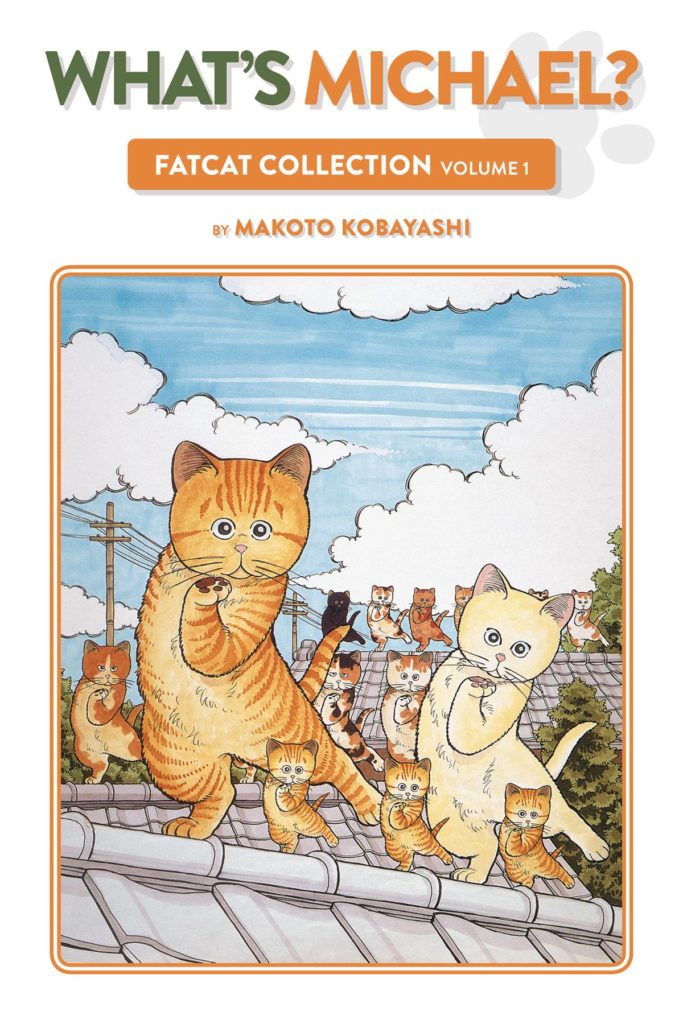
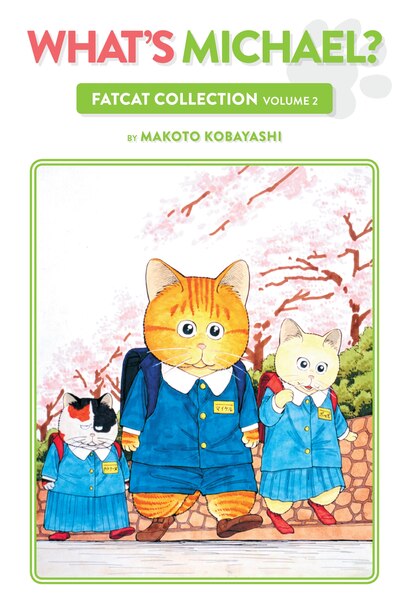
01:45 Here’s how Dark Horse describes What’s Michael? Fatcat Collection Volume 1.
True-to-life daily cat scenarios and off-the-walls crazy feline fantasies combine in this epic manga collection. Makoto Kobayashi’s hilarious New York Library Award and Parents’ Choice Award Winning Series returns in a set of oversized collections.
Dark Horse Comics
What’s Michael? FatCat Collection Volume 1 contains the out-of-print original What’s Michael? Volumes 1 to 6. Over 500 pages of tumultuous fun, including the out-of-print volumes Michael’s Album, Living Together, Off the Deep End, A Hard Day’s Life, Michael’s Favorite Spot, and Michael’s Mambo.
2:30 Deb mentions the manga Cat+Gamer by Wateru Nadatani, translated by Zack Davisson, another cat manga published by Dark Horse.
[DEB:] Cat + Gamer is a little less silly and fanciful than What’s Michael, but it is a darn cute story about a single gal who’s a no-nonsense, get-the-job-done office worker by day, and a hardcore gamer by night. So when a stray kitten is found at her workplace, she stuns her co-workers by agreeing to adopt the lil’ critter. It’s only later that she comes to the realization that she has never owned a cat before, and she’s got to figure out how to ‘level up’ to the responsibilities that come with co-habitating with a kitten.
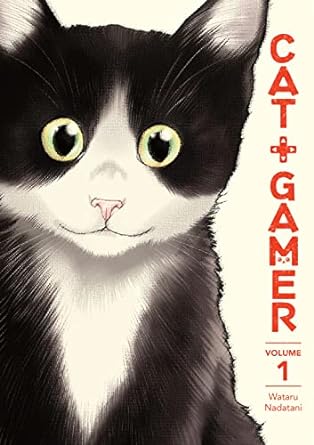
3:00 As you know from listening, both Deb and Chip have cats of their own. Christopher can’t have a cat because he travels too much, and David has leaves a respectful distance between him and the cats in his apartment building, but isn’t averse to cats, per se. But since we mentioned them, here are some adorable photos of Chip’s cat, Mr. Sweetpea:
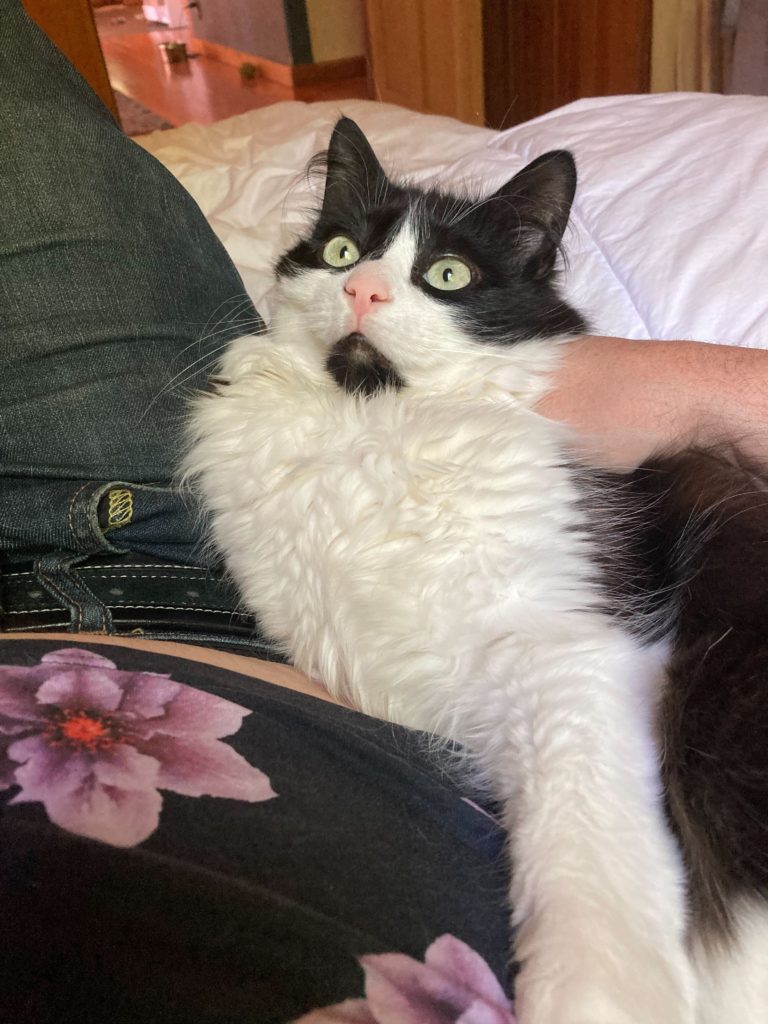
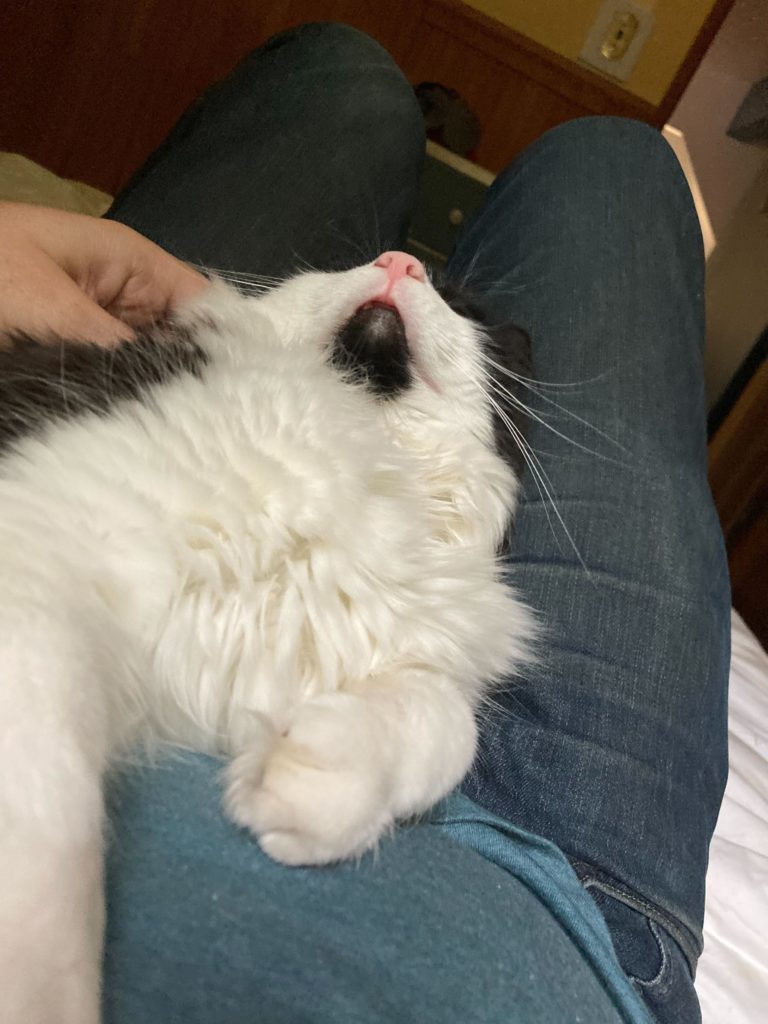
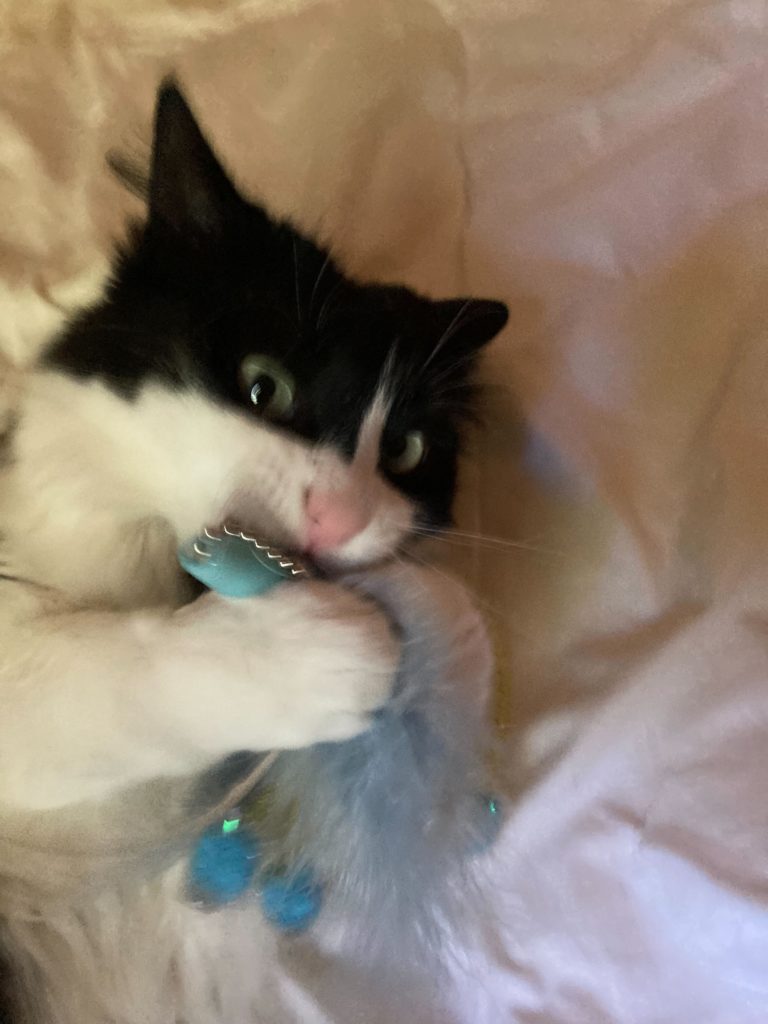
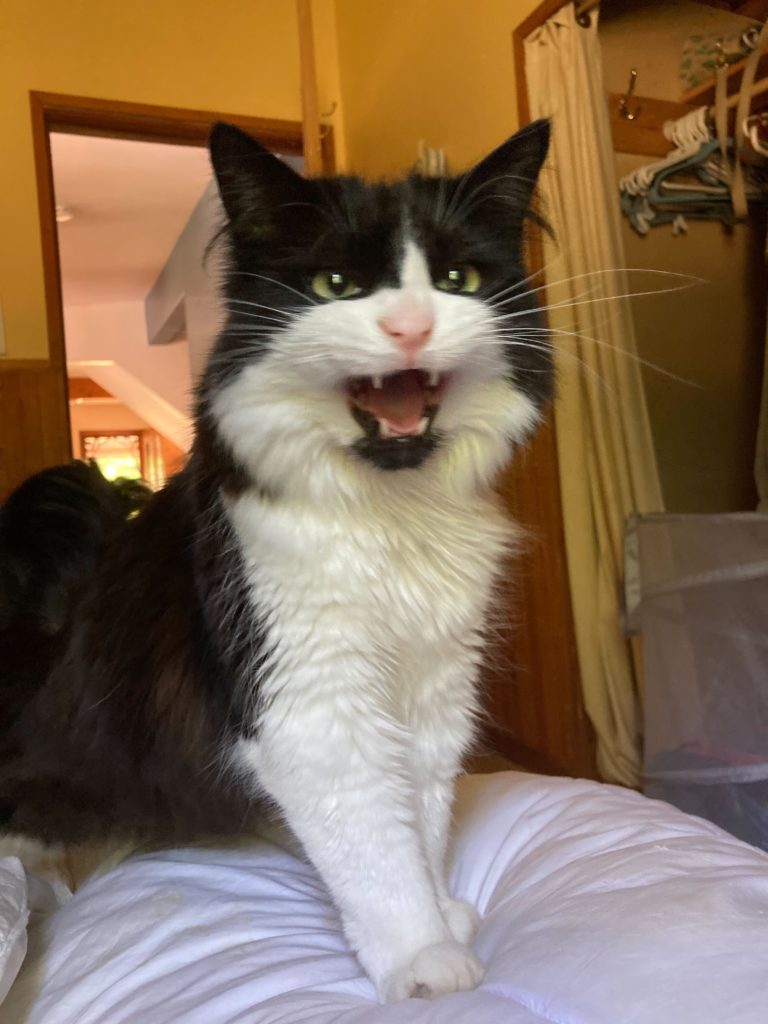
Fierce! And since we’re sharing, here’s Deb’s precious little muffins Franky and Sunny.
[DEB:] Altho given how these cat brothers wrestle with each other, I probably should have stuck with my original names for them, Zoro and Sanji. Oh well.
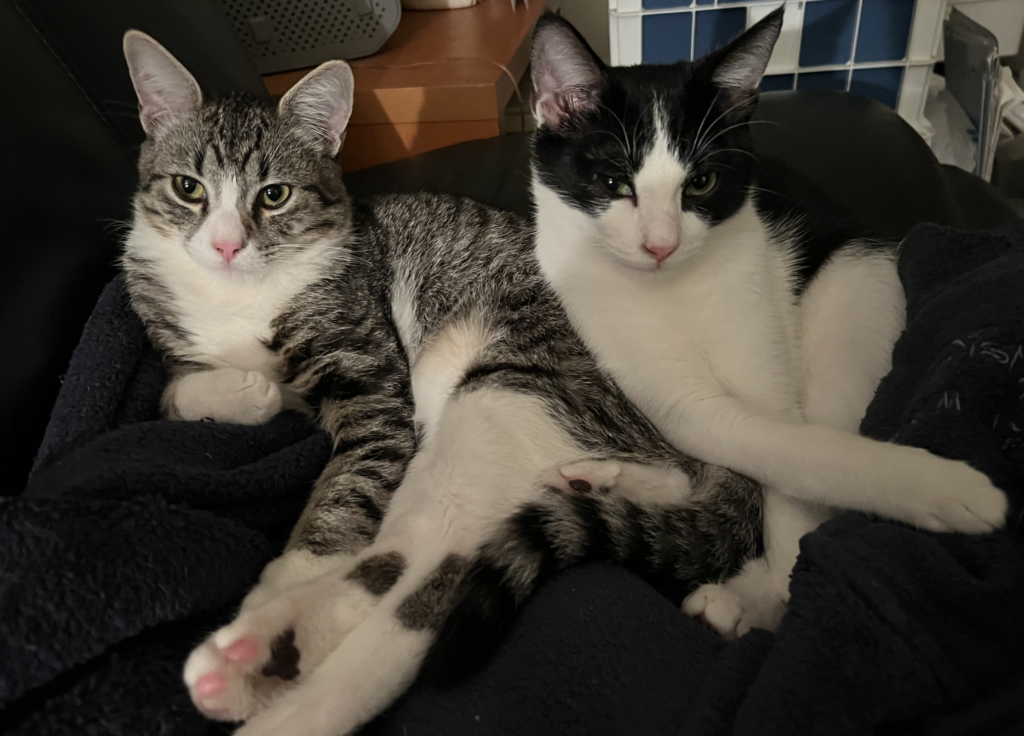
04:30 Sometimes it’s ‘reality’ and sometimes it’s ‘fantasy.’ But it’s always What’s Michael?
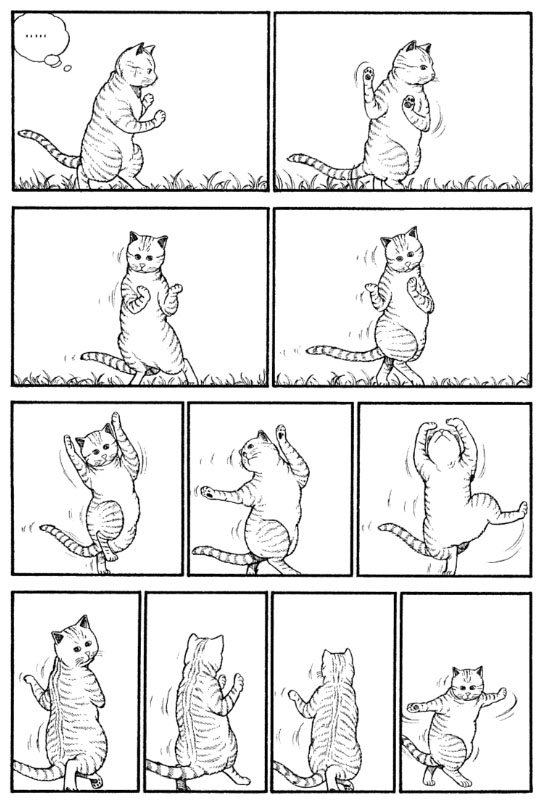
6:40 So while researching this episode, I discovered, as above, that the early What’s Michael? stories date back to a translation from 1990, and are lettered very much in the spirit of manga at the time. Contrasting it to the work at the end of book one, which would have been in the Dark Horse edition of What’s Michael? Volume 5, that material was lettered and published around 2001 or 2002. The industry changed a lot during that time, and the lettering is a good example of how much!
Deb mentions page 102-103 as looking particularly good with sound effects.
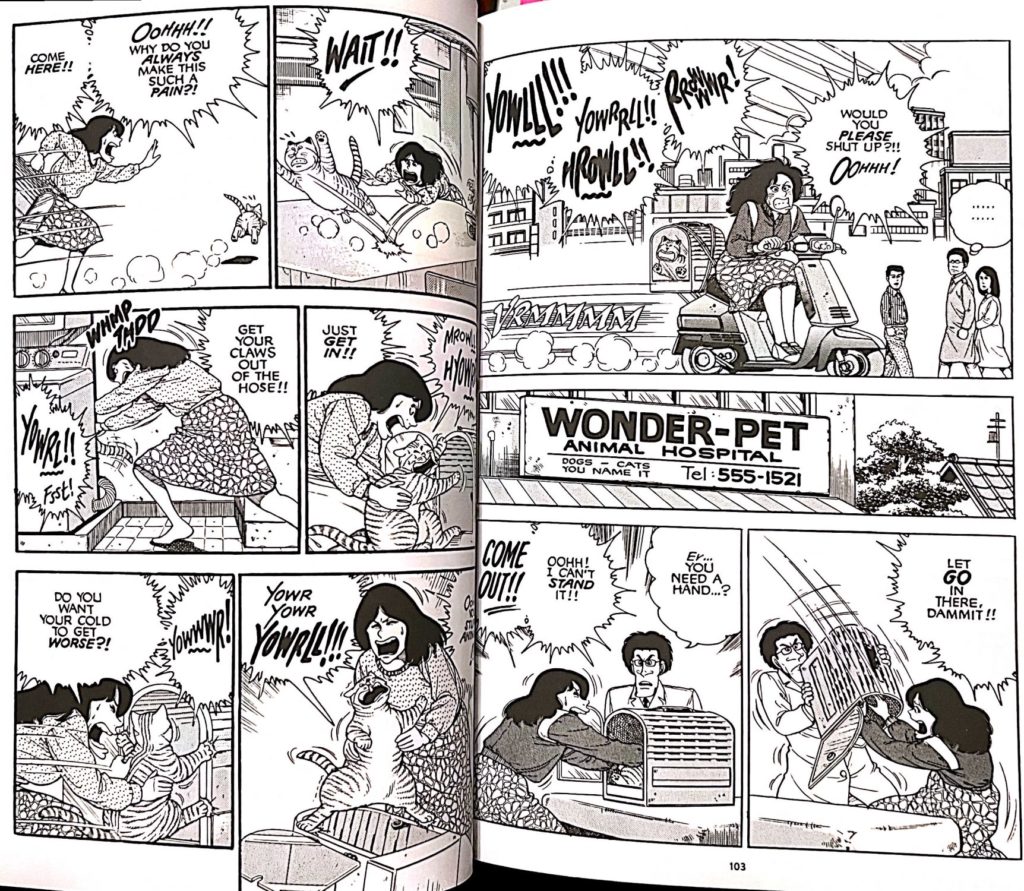
Christopher mentions page 156 as being really strong too.
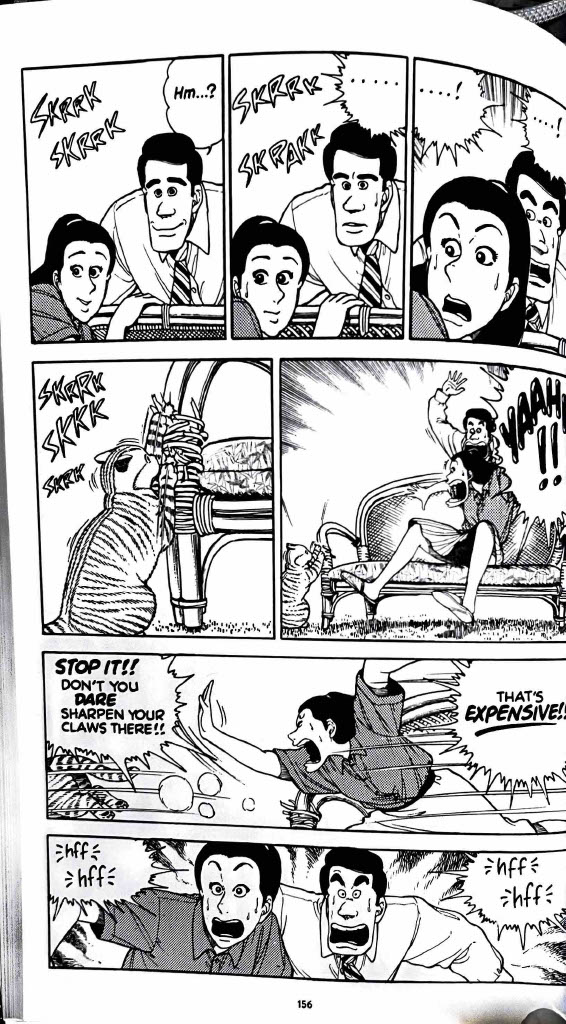
Chip then mentions page 460, from later in the series, where the lettering doesn’t work very well. The text from the dog doesn’t quite flow, and it looks like they’re trying to match the hand-lettering style from earlier in the series using only fonts and what’s probably a primative version of Adobe Illustrator, and it’s not really working out.
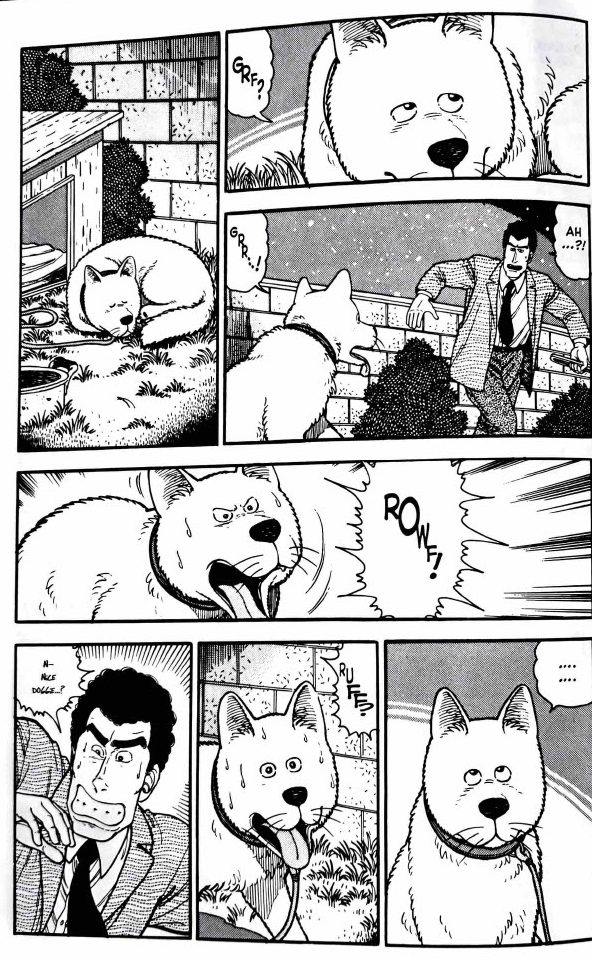
13:15 David loves the Lionel Ritchie-looking dudes from 80s gag humor manga. It’s a thing for real, it was the style at the time.
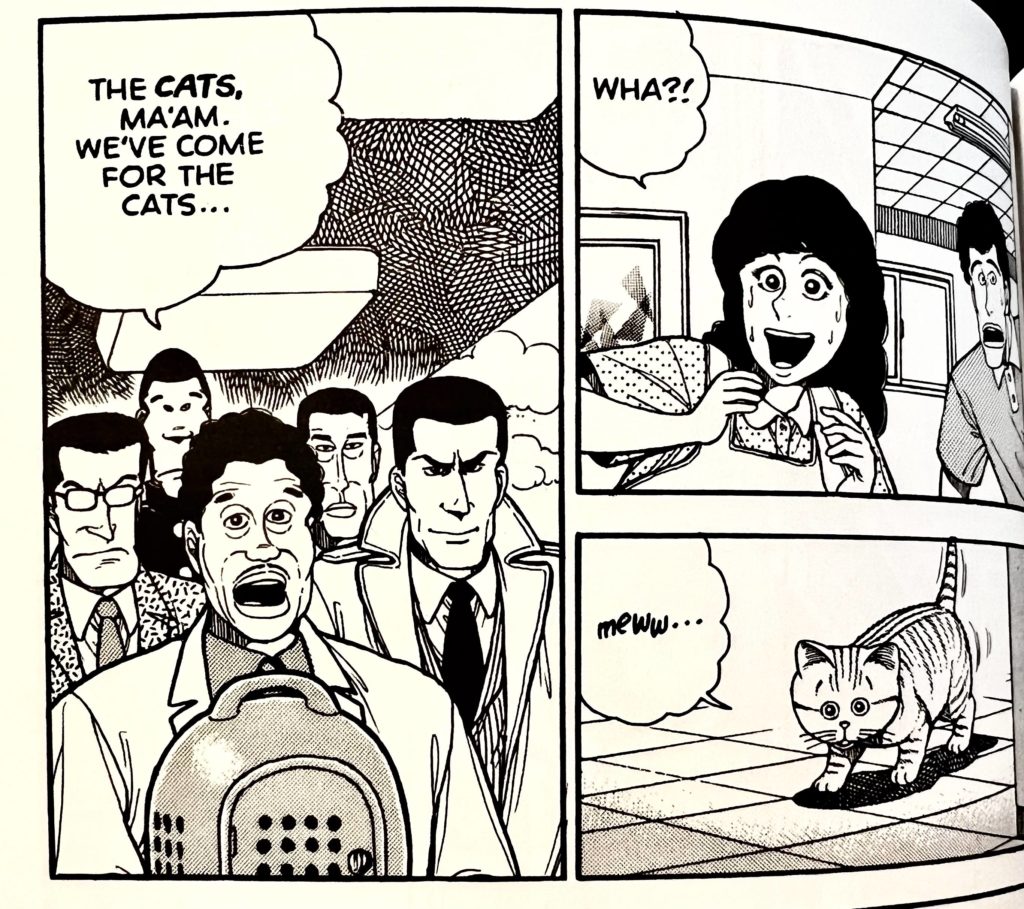
David later mentions page 273 as being the most Lionel Richie-like character, and that’s hard to disagree with.
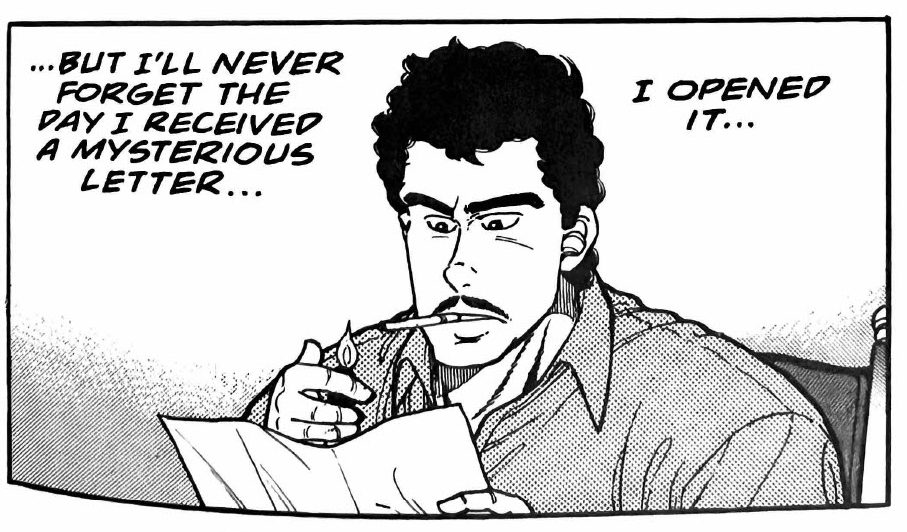
14:30: One of the last stories in the book is Michael as a salaryman in a world of cats, which is funny enough, but we find out in the last panel that the whole escapade is just Michael’s owners thinking ‘what-if’ as they watch their kitty snoozing away and perhaps having a bit of a bad dream.
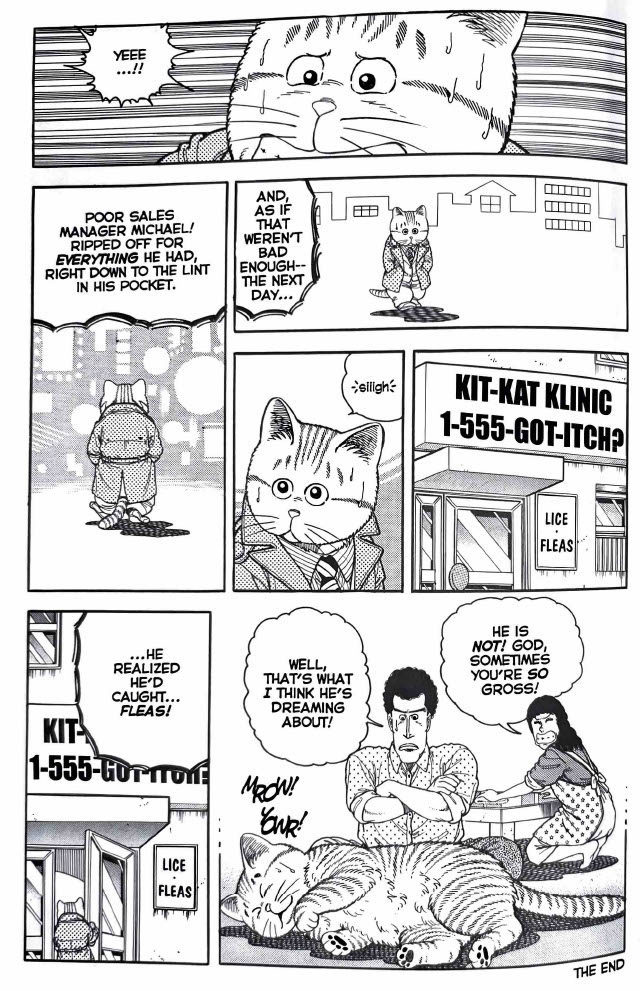
I understand what this is, and why the author introduced this idea that the whimsical/fantastic Michael stories might just be his owners making up stories about him… Sort of like how Kobayashi-sensei is making up stories about him? This was a stumbling block for Chip in his reading, trying to find a level with the work where the reference works are more consistent in their setting.
21:00 Yeah, the story where Michael is in heat is weird. It’s a good reminder that this isn’t exactly an ‘all-ages’ series, but was published for ‘general audiences’ in Japan. Still, it seemed to win some sort of Parent’s Choice award in N. America, so good on it! That said:

RIP Bob Barker.
24:20 Actually the lettering on Teenage Mutant Ninja Turtles #1 isn’t too bad. MY BAD.
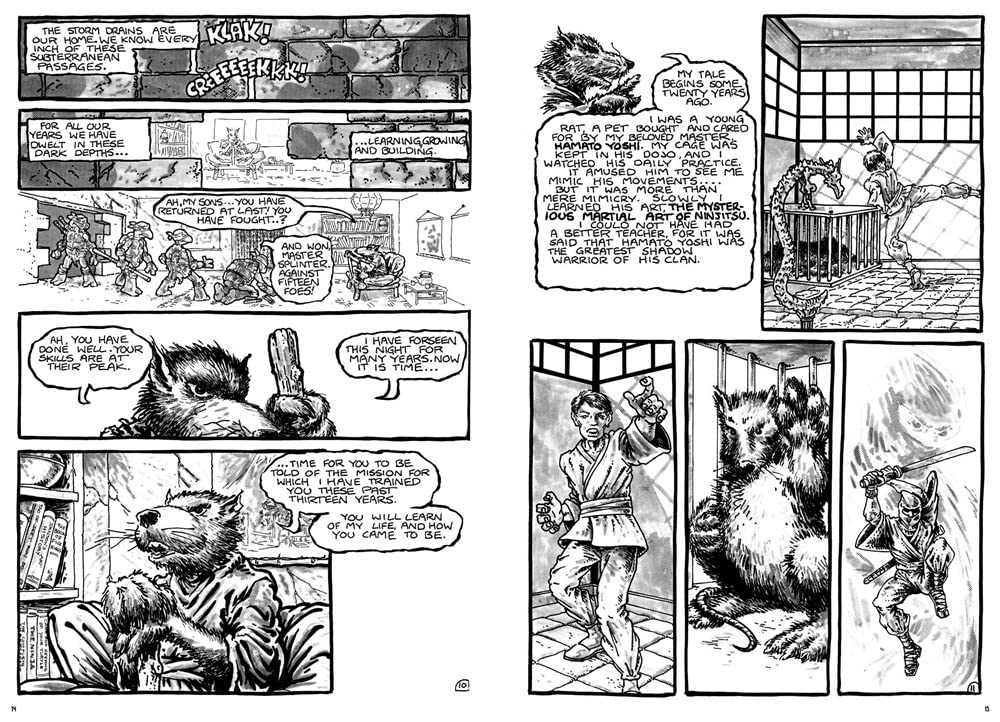
26:10 That project I’m talking about is Noodling in New York by Akino Kondoh. You can read it on Mangasplaining Extra, and see a comparison between a Japanese page and my English edition.
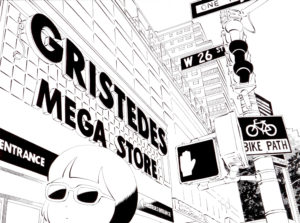
26:45 Continuing the lettering discussion, while What’s Michael?’s computer sound effects lettering is early days and not, like, our fave, a lot of computer-assisted sound effects lettering in manga these days can look great, and really capture the feeling of the Japanese work. I think the many of the letterers working today are as talented at their craft as anyone who’s worked in comics lettering before, and they’re working at insane speeds for much lower pay than they probably should.
Case in point: We’re currently running the series Search and Destroy by Atsushi Kaneko on MSX: Mangasplaining Extra, which is being lettered by the great Phil Christie. Before Phil came on, I needed to letter a few pages for Fantagraphics’ solicitation of the work, and so I banged out a fairly decent job using fonts. Phil came in and lettered the final version though, hand-lettering the effects, and man, it’s just so much nicer than what I was able to do with my skills. Hats off to him.
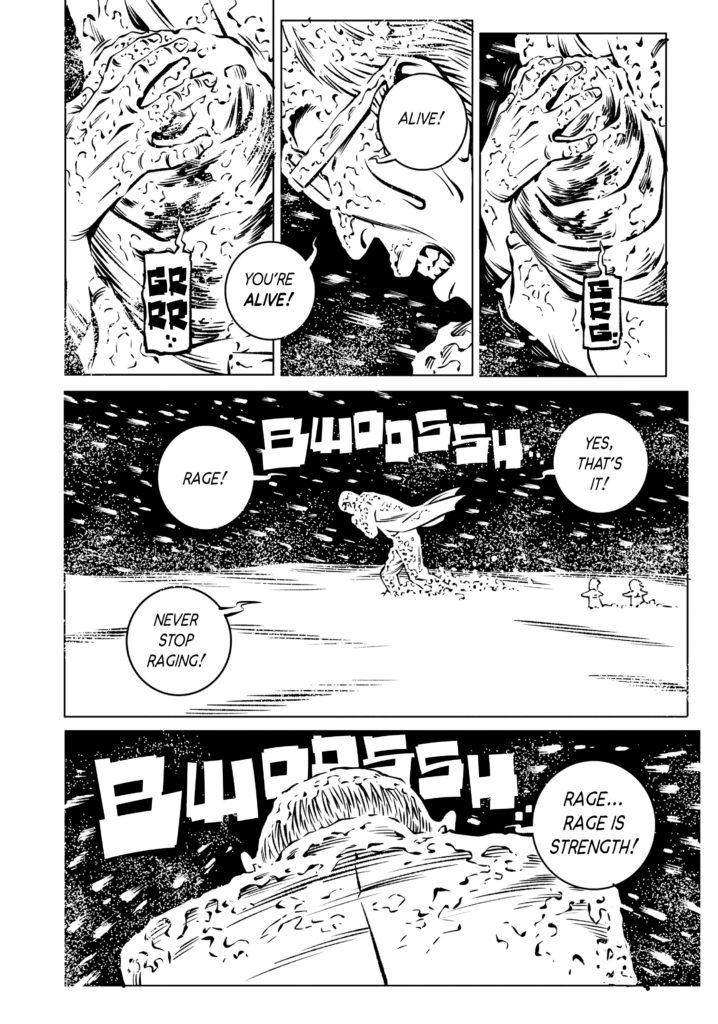
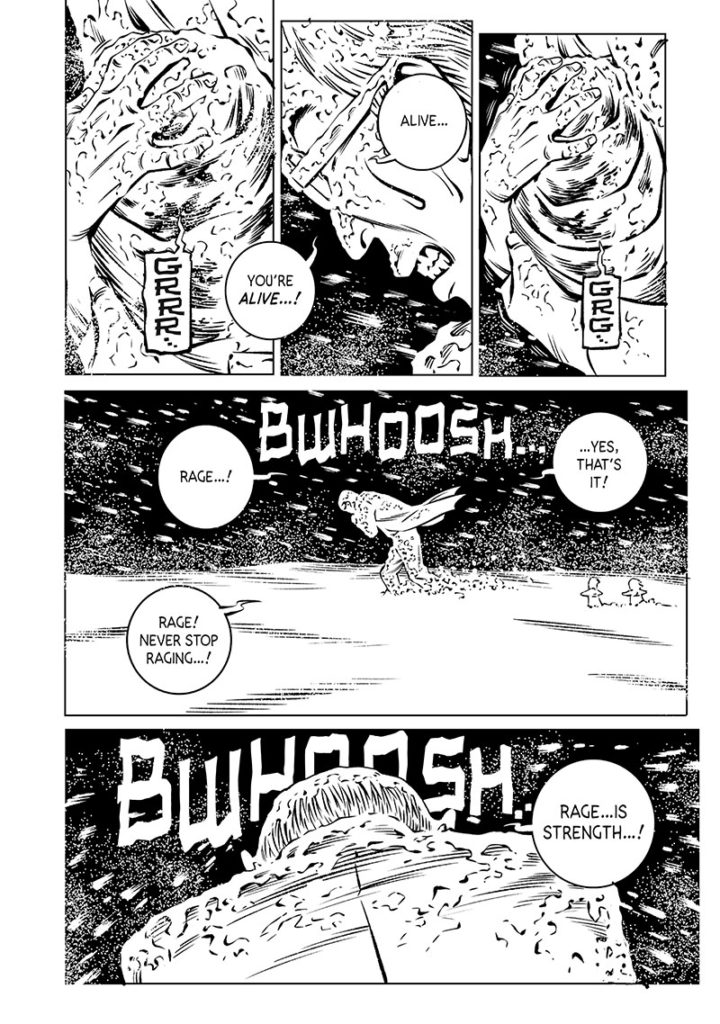
So yeah, none of this discussion is a knock on any professionals working today. It’s more of a “the transition to digital lettering was not smooth and we’ve come a long way.’ Hell, the transition to digital colouring was even bumpier, frankly, and artists are still coming up with incredible new uses of color in their stories. No shade to anyone involved in this book. 🙂
28:00 David and Chip mention some great superhero lettering, with the team of John Workman and Walt Simonson on Thor doing some great work, and Frank Quitely illustrating his own stories, including sound effects.
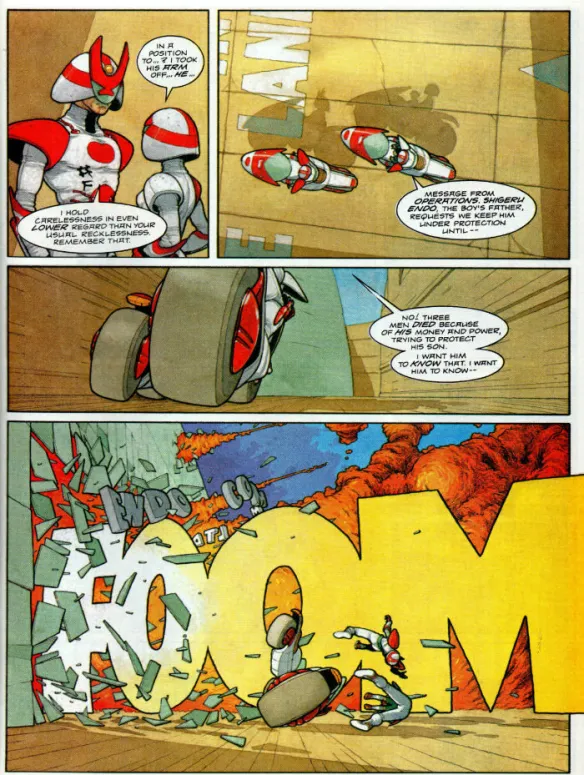
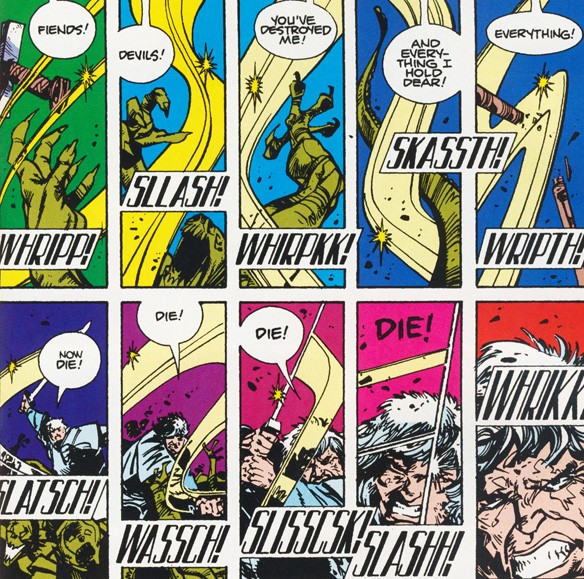
30:30 This book is FLOPPED! Or flipped. Whatever. That basically means that it reads in the North American orientation of left-to-right. I don’t think we mentioned that up front? If you’re one of the rare listeners of the podcast who has trouble reading manga because of the reversed page layout, well, this one’s for you!
31:50 Deb mentions a few hidden callouts in the early episodes of What’s Michael, courtesy of the translators.
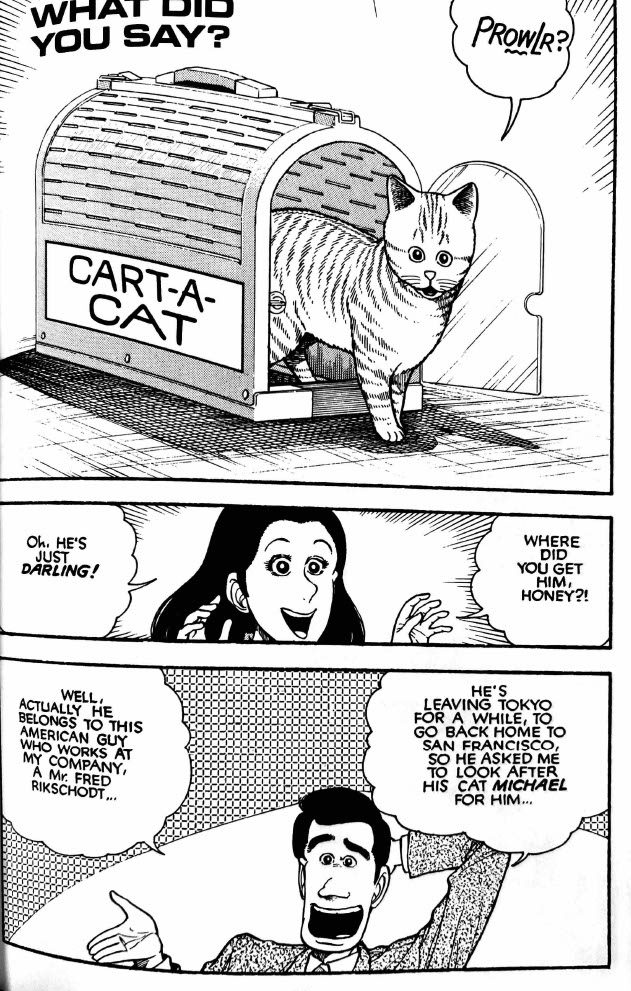
On page 19, “Trina” is mentioned, which might be groundbreaking feminist comics creator Trina Robbins.
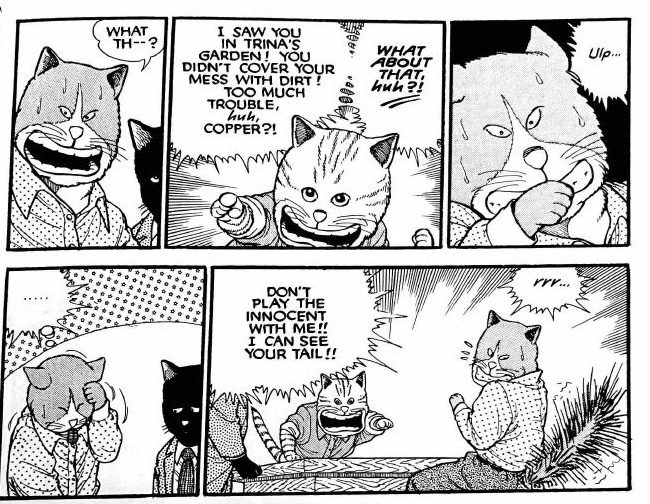
32:15 But one callout that Deb couldn’t figure out is the “Freyman reaction” on page 341.
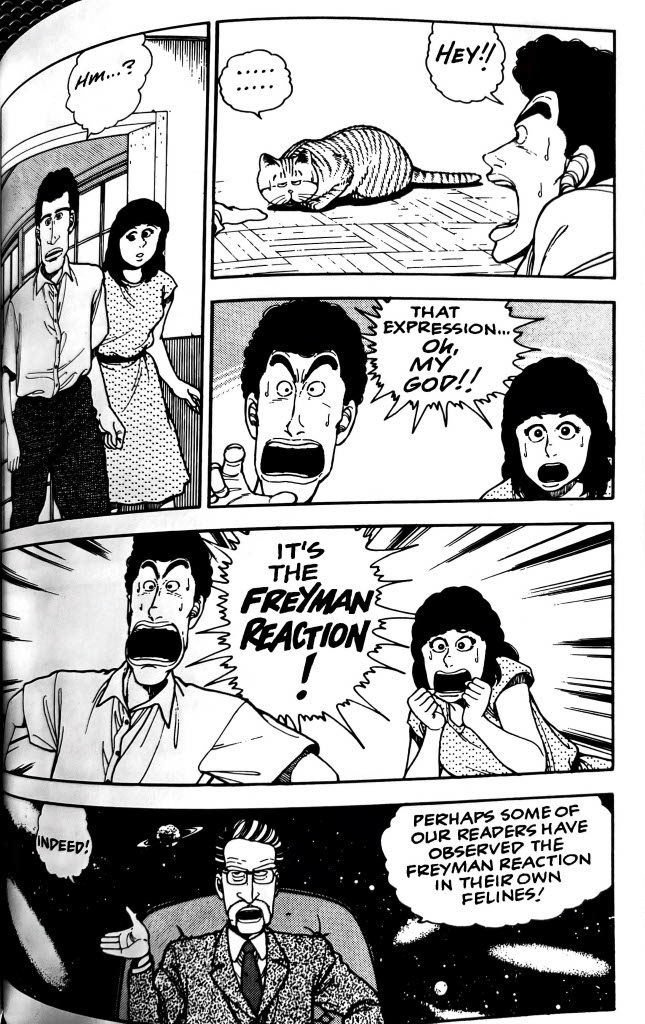
That’s because it isn’t real! Luckily, David caught that this is actually the Flehmen Response, a face that cats and other animals make when they smell something bad. Looks like, as David said, the translator’s Googling failed them, and they just transliterated the Japanese katakana word. Might wanna fix that for the second printing, Dark Horse.
“The flehmen response (/ˈfleɪmən/; from German flehmen, to bare the upper teeth, and Upper Saxon German flemmen, to look spiteful), also called the flehmen position, flehmen reaction, flehmen grimace, flehming, or flehmening, is a behavior in which an animal curls back its upper lip exposing its front teeth, inhales with the nostrils usually closed, and then often holds this position for several seconds.”
Wikipedia
Deb also mentions “Danbo” and “Cardbo” here, which is a reference to a character in the manga Yotsuba&!. Danbo/Cardbo is a robot made of cardboard boxes that pops up in a few stories in Kiyohiko Azuma’s slice-of-life comedy manga series. Why do we refer to it as having two names? Well, in the original English edition from ADV’s short-lived publishing wing, the character was called “Cardbo” as a portmanteau of “Cardboard” and “Robo” or robot. However, when the series was later picked upd by Yen Press, they kept (or were made to keep?) the original Japanese name, Danbo, from the Japanese “Danboru” meaning “corrugated cardboard.” It made English language fans sad, but them’s the breaks.

35:45 Manga really did used to look different in North America, and What’s Michael? is a nice reminder of that. At least for the first few hundred pages.
David does mention we went REALLY in depth on AKIRA’s different editions, complete with very different lettering. I’ve written a TON about that in our show notes for AKIRA, and if this is something that fascinates you as much as it apparently fascinated us, well, dig into the archives and enjoy the read.
Mangasplaining presents: Akira volume 1 | Akira volume 2 | Akira volume 3
39:30 The dancing sequence with the ribbon is great:
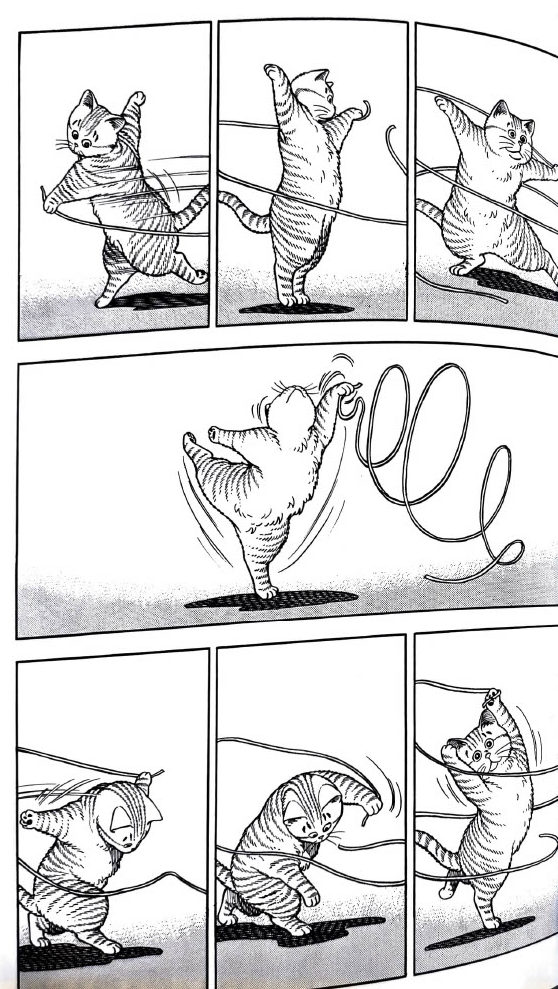
But Chris and David loved pages 194 and 197 for that traditional dance sequence.
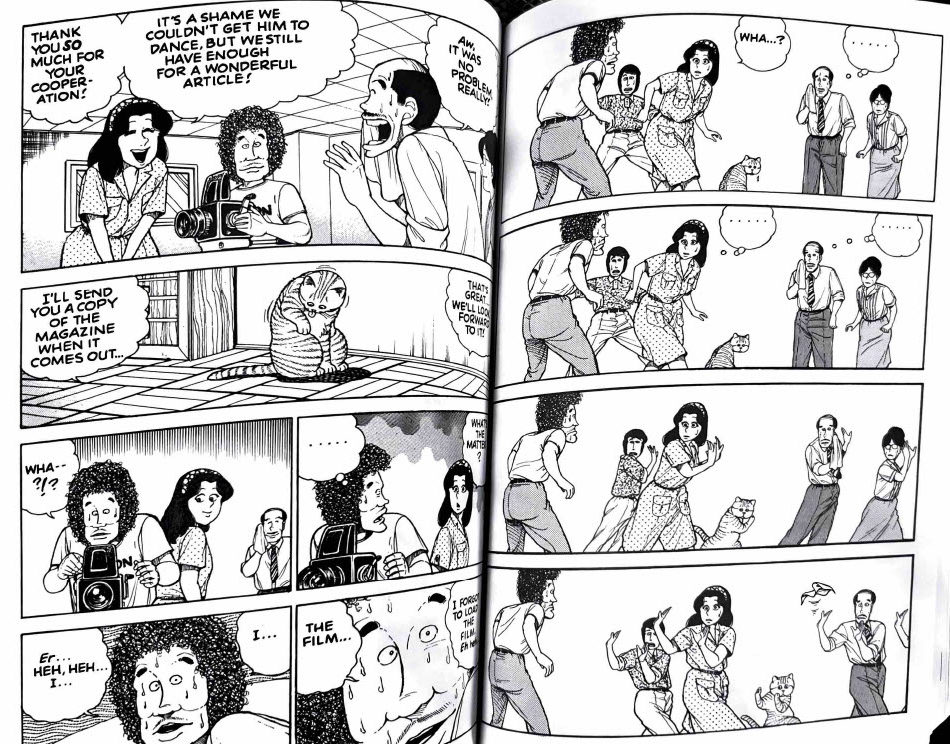
[DEB:] By “traditional dance,” we’re basically referring to traditional Japanese dancing that you see at seasonal events like at Bon Dances in summertime or at festivals like the Awa Odori festival in Tokushima in Shikoku, Japan (which I actually attended once, so that’s why it comes to mind).
40:50 Chip’s fave story is the character saying that he likes cats but they’re not the same as people. And mentions page 154, which shows just how close Michael and his owner really are, as another standout scene that he likes.
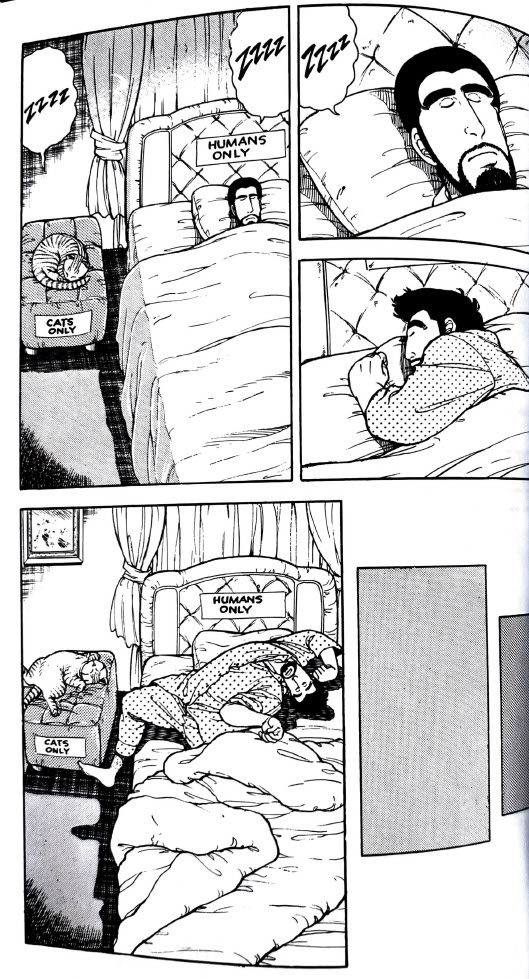
41:30 Chip also loves this panel on page 105, of Michael’s arm over a human arm in the vet story.
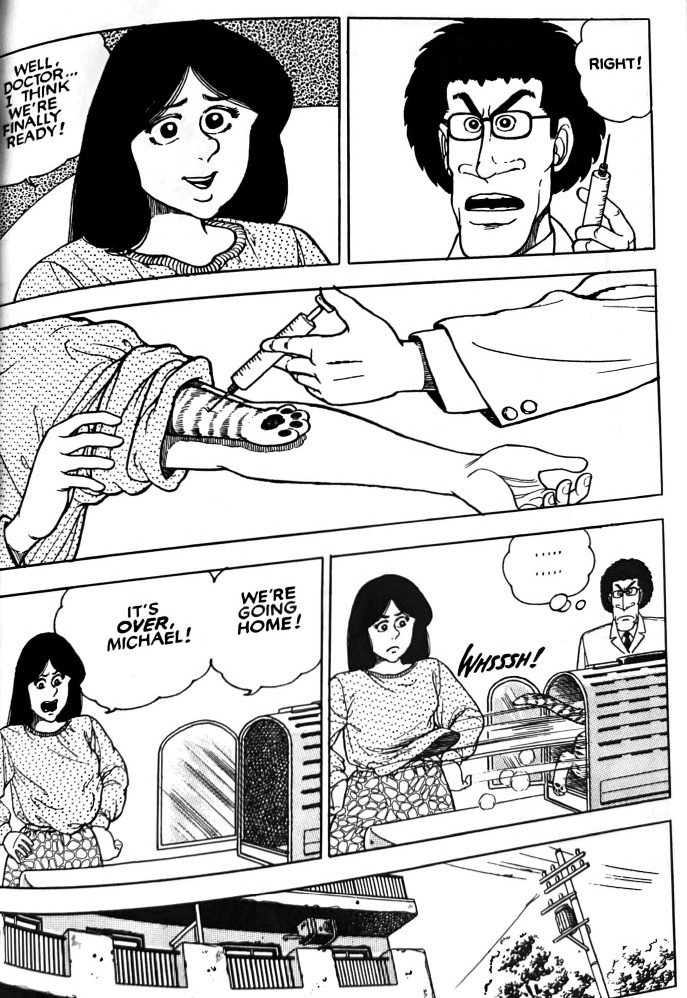
David mentions a favorite bit a few pages later, on page 107, where he ends up getting along with the cat by just eating his dinner and ignoring him. Perfect moment.
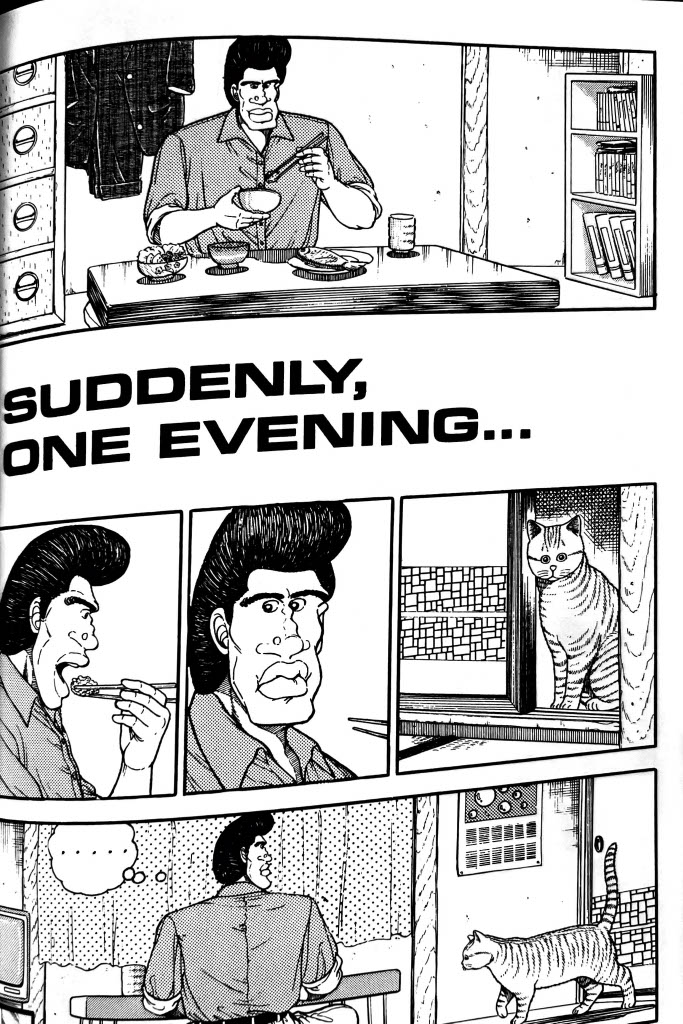
He also loves all of the cat expressions, but specifically Michael’s face when he sees Popo the kitten on page 127.
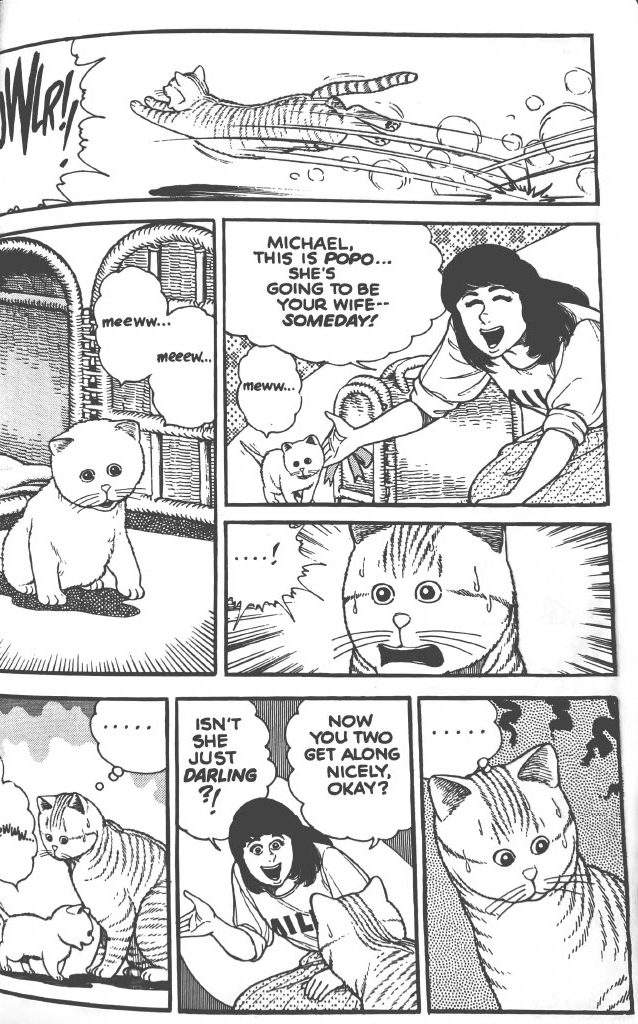
44:28 And here’s when Garfield and Heathcliff enter the picture. I agree with Deb, that Garfield and Heathcliff always seemed to consider themselves “above” the other characters. Also interesting is that while Garfield was one of the first comics I read and one of the ones I loved the most, Heathcliff was always more of an animated show to me… But then that’s what Garfield became too. Maybe it was because of the time I grew up?
Also, that opening was animated in Japan, you can kind of tell from the quality and style of the animation. It’s so much better than it has any right to be.
But David mentions that the daily Heathcliff comic strip by Peter Gallagher has gotten real, real weird and interesting. Here’s a few recent Heathcliffs for example.
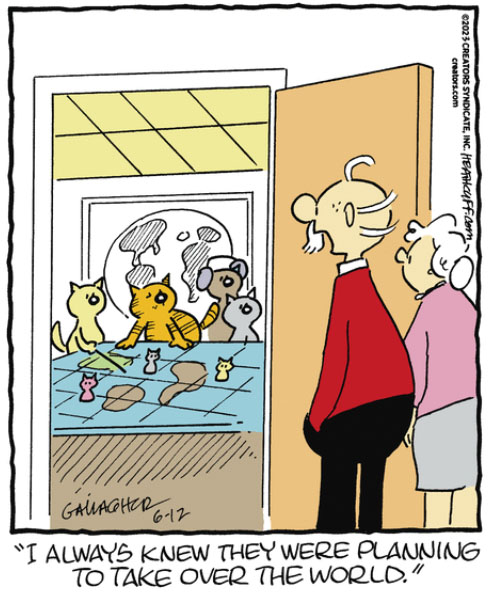
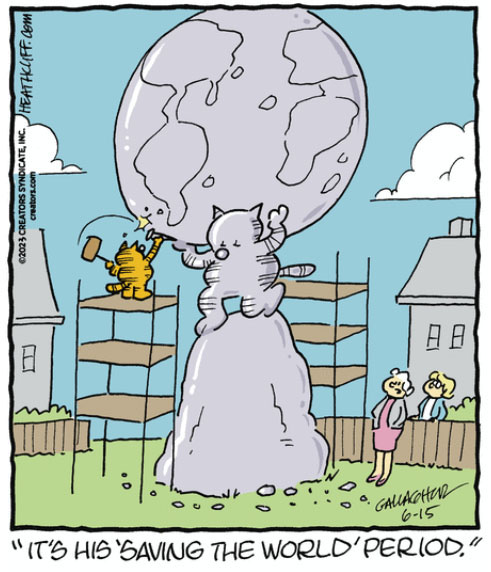
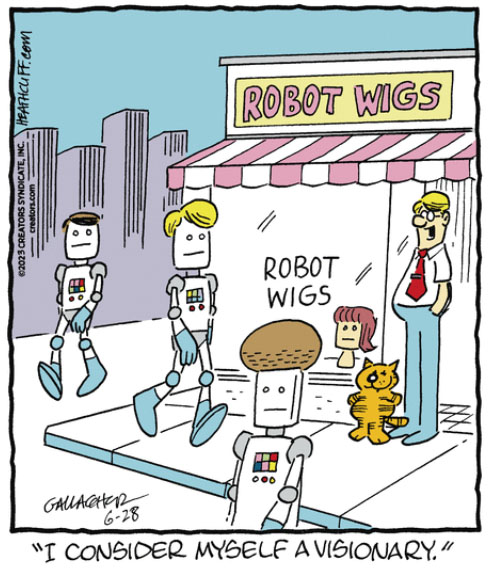
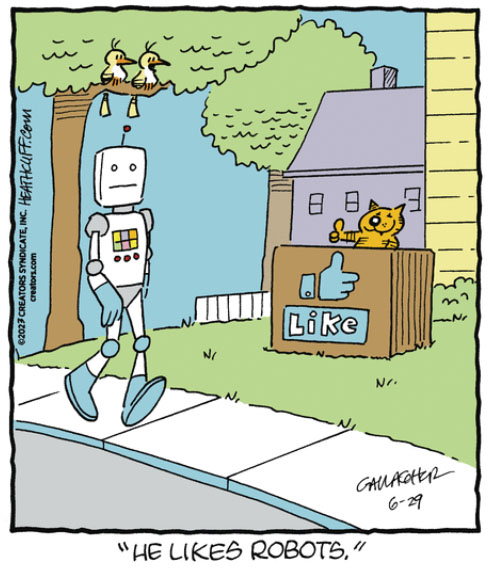
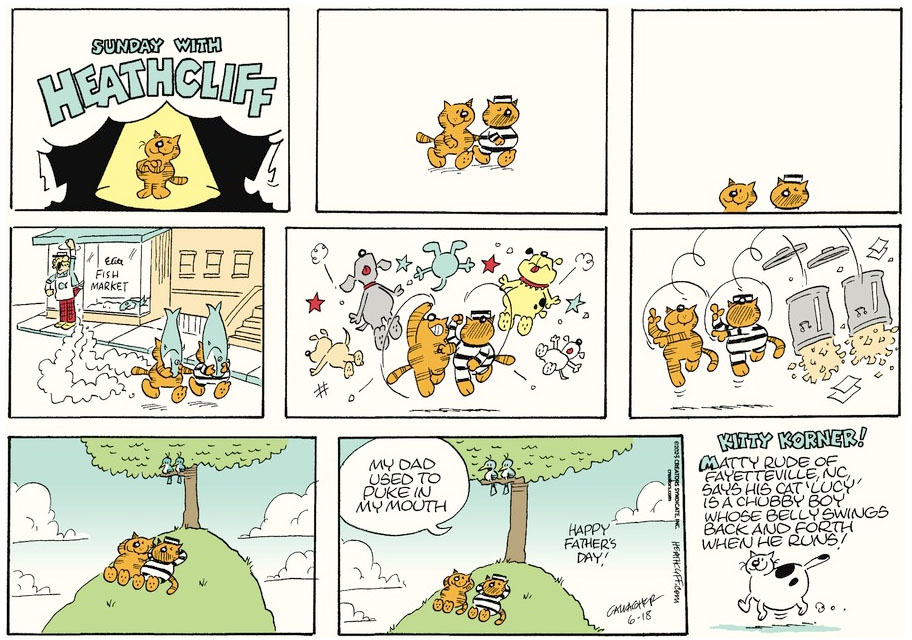
Yeah, it’s weird. Got some of that Olivia James’ version of the Nancy comic strip going on.
47:59 We mentioned the meme-ification of What’s Michael? here. We’re specifically referring to this Dracula scene, which was passed around quite a bit. You can read it in Minovsky’s Twitter post here, for reference.
And Garfield’s breakthrough meme moment? Garfield Minus Garfield, which is a strip where Garfield is removed from the strip and it makes John look completely insane. I’ve been watching a lot of “I Think You Should Leave” with Tim Robinson lately, same vibes.


This causes David to remember his friend Gavin’s “Darkseid Minus Darkseid,” which is a pretty great series of images on David’s old site 4thletter.
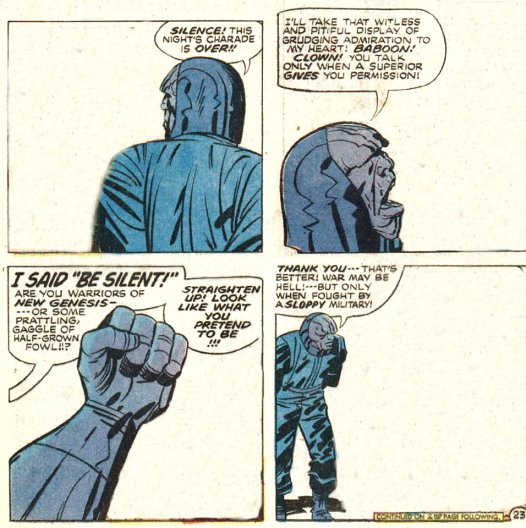
51:30 I think Deb’s right, it IS a little weird that he didn’t do What’s Michael? for the rest of his life. It was popular enough, it got an anime (and if he had kept going, it might’ve gotten another). It had merch potential. It wasn’t quite as kawaii as Chi’s Sweet Home though. It looks like Kobayashi decided he had a different path he wanted to follow. But if he ever has a change of heart, Michael’s What A Kitten Adventures! has a nice ring to it.
Oh, and the next books Kobayashi-sensei did according to Wikipedia, include Judo Club Story, Heba! Hello-chan (aka Club 9), Gabrin, and a bunch of one-shots and shorts.
54:20 David mentions that the story began on page 205 with a Lionel Richie-esque lead is very relatable, due to his brief run-in with a cat forever creasing his beloved Iconapop poster:
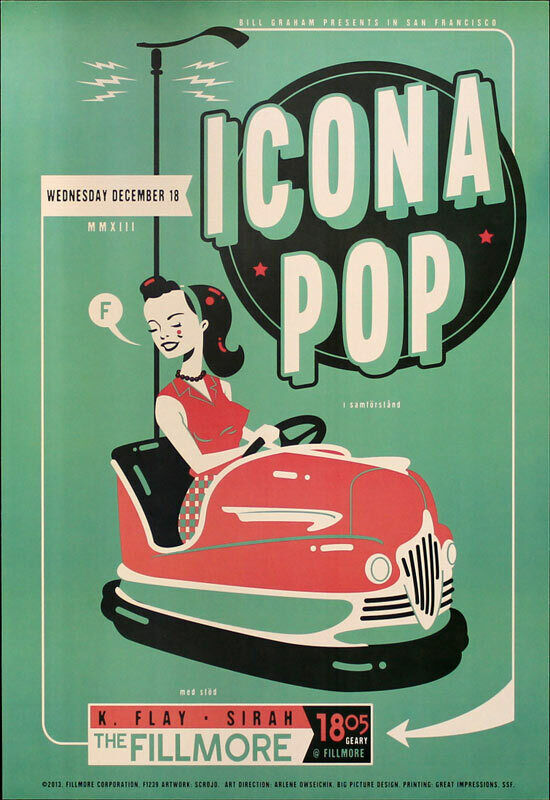
What, you thought we would show you David’s apartment? Never! 😉
And that’s it for the main episode, but don’t worry, things are JUST AS CRAZY after the break!
57:30: THE BREAK
58:00: It’s time for Q&A, aka The Mangasplaining Mailbag! Chip has a question from his good pal, comic book creator Matt Fraction:
“Hey chum! Can you ask the Mangasplaining crew if Miyazaki’s Porco Rosso (manga) ever got an English publication? Or if they may happen to know if it’s gettable or findable at all in print? i’ve Googled and failed.”
-Matt Fraction
Okay so, I basically cocked this up a bit, by virtue of deeply oversimplifying, in my answer here. If I could cut this out of the podcast I would, and restate it clearly, but I can’t, so here we are. Please take this accurate information as a mea culpa.
The good folks at Nausicaa.net, aka “The Ghibli Wiki” run one of my favorite, long-running fan-sites for anything on the net, although in this instance, it’s all information about the work of Hayao Miyazaki and Studio Ghibli. As expected, they have the real answer (and more info than you could possibly imagine). I’m here to summarize it for you here.
Hayao Miyazaki had a semi-regular column in Japanese scale-model magazine Model Graphix called “Zassou Note.” This ‘column’ would be entirely illustrated, fluctuating between a detailed drawing with notes and caption boxes, all the way through to more traditional comic-strip type narrative stories. They mostly looked like this:
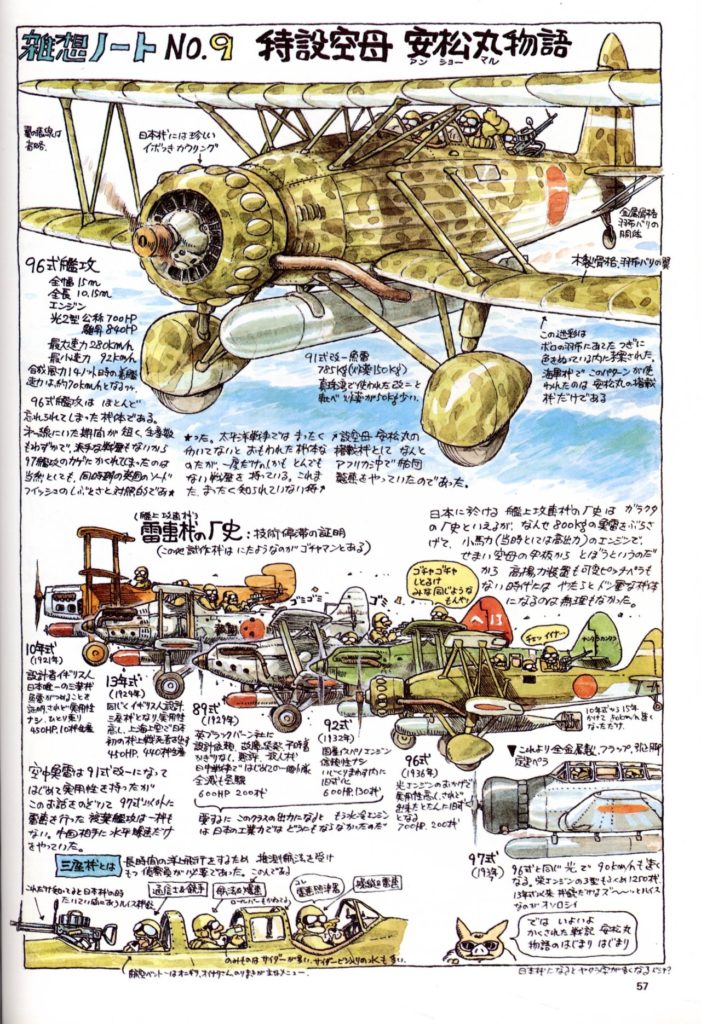
These columns were collected in Miyazaki Hayao no Zassou Nooto, or, Hayao Miyazaki’s Daydream Data Note. An earlier (1992) edition contains only the first batch of columns, and the expanded 1997 edition (picture below) contains all 13 chapters, which is important for fans of Porco Rosso.
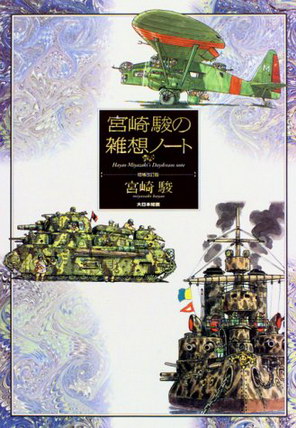
The twelfth chapter in Daydream Data Note is entitled “The Age of the Flying Boat”, and it is, in fact, the short manga story that Porco Rosso is based on. It’s 15 pages (serialized across 3 issues of Model Graphix), watercolor and illustrated, and is a lighthearted telling of some of the events of the film, with some pretty gorgeous artwork. Here’s a page:
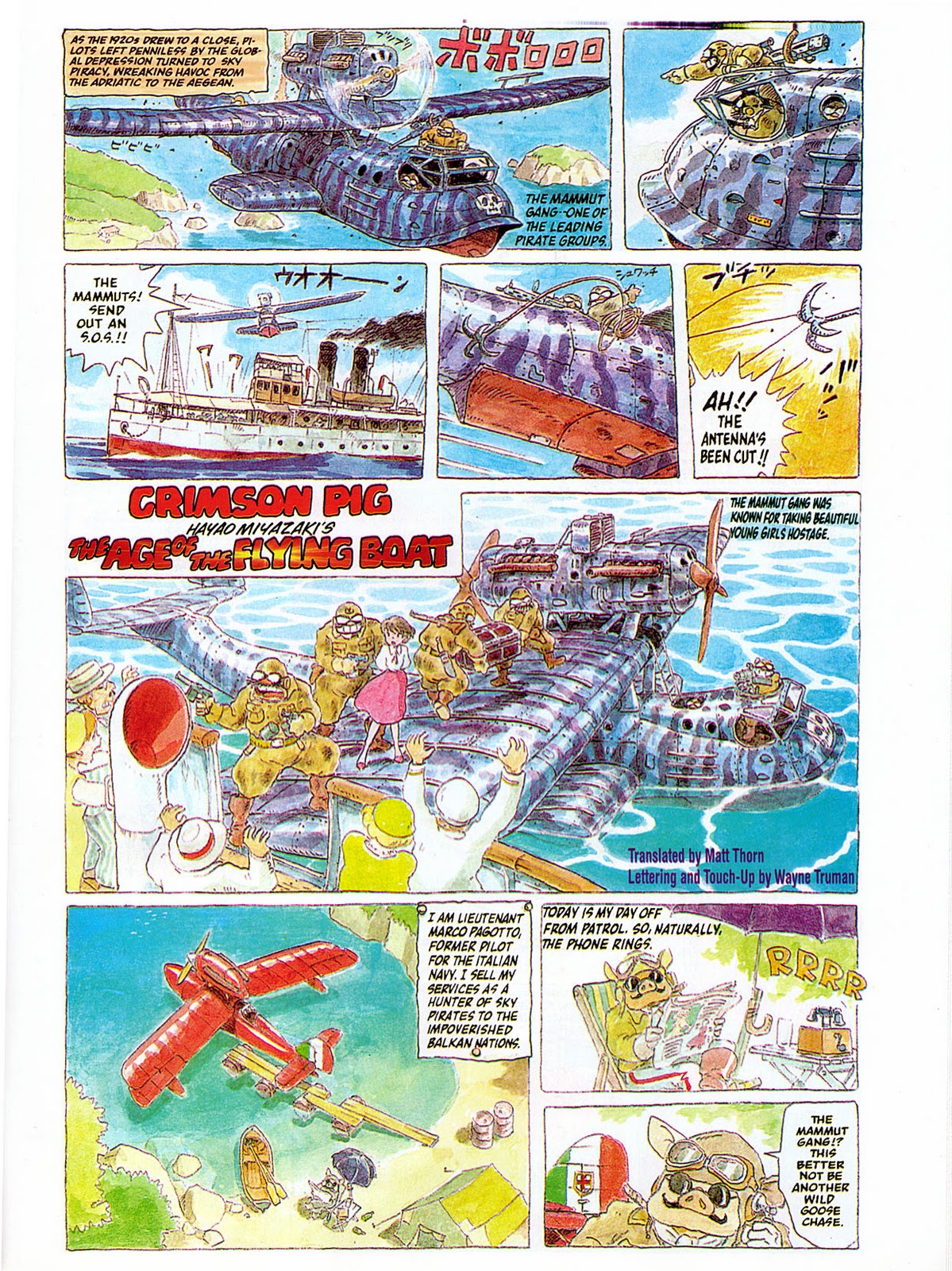
It’s worth noting that this 15 page story was also reprinted in another book just called “The Age of the Flying Boat”, and the expanded edition mentions Porco Rosso on the cover, but is still just 15 pages of story, alongside another 57 pages of airplane diagrams, model kit photos, and an interview with Miyazaki about those things. The cover maybe makes it look like Porco Rosso the manga, but that’s not exactly right, it’s more of a 72 page MOOK with 15 pages of comics in it.
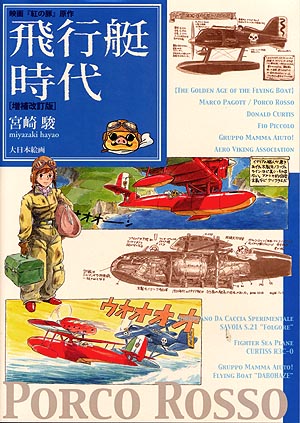
Now, here’s the part I completely forgot to mention: The story “The Age of the Flying Boat” was legally, officially translated into English by Rachel Thorn and lettered by Wayne Truman and published… Across issues #5, 6, and 7 of the magazine Animerica, published by VIZ Media back in 1993. That’s where that page up top is from.
These are very out of print, and I imagine pretty difficult to find, unless you’ve got mad eBay skills. So yes, there was an English, printed edition. And as Fraction mentioned, some of the pages were reprinted in The Art of Porco Rosso, but from my searches it looks like only the first 5 pages (of 15), and four of those are printed real small.
As a side note, I just checked Mandarake and they have a few copies of the Japanese editions of the above book as well as Daydream Data Note, but they’re missing the obi-band and show some wear-and-tear, but they ARE in stock for about 20 bucks right now. Maybe the expensive one I saw was some pristine outlier? Or maybe demand has softened? Either way, it’s not unaffordable, but it’s not getting less-rare, either. Scoop it up quick if you’re desperate.
So yeah, I got about 65% right, maybe 70%, without doing any sort of research. I will shoot for higher in future episodes, sorry! Today’s lesson is: Don’t answer complicated questions with half-remembered ideas of what’s in certain books.
Oh, and if you want to read “Hayao Miyazaki’s The Age of the Flying Boat”, literally pop that into Google, it’s pretty easy to find. It’ll make you a filthy pirate, but…
Okay, back to regular show notes.
58:55 David says “Better a Pig than a Fascist,” and that’s almost a quote from the film that became a pretty popular meme.
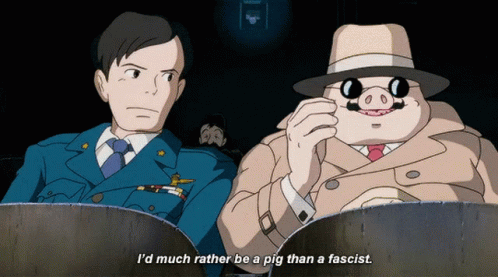
1:00:00 These little pig characters would make their way into future comics from MIyazaki too. He did a few short comics relating excerpts of commanders’ memoirs from WWII. I really, really wish these could be published.
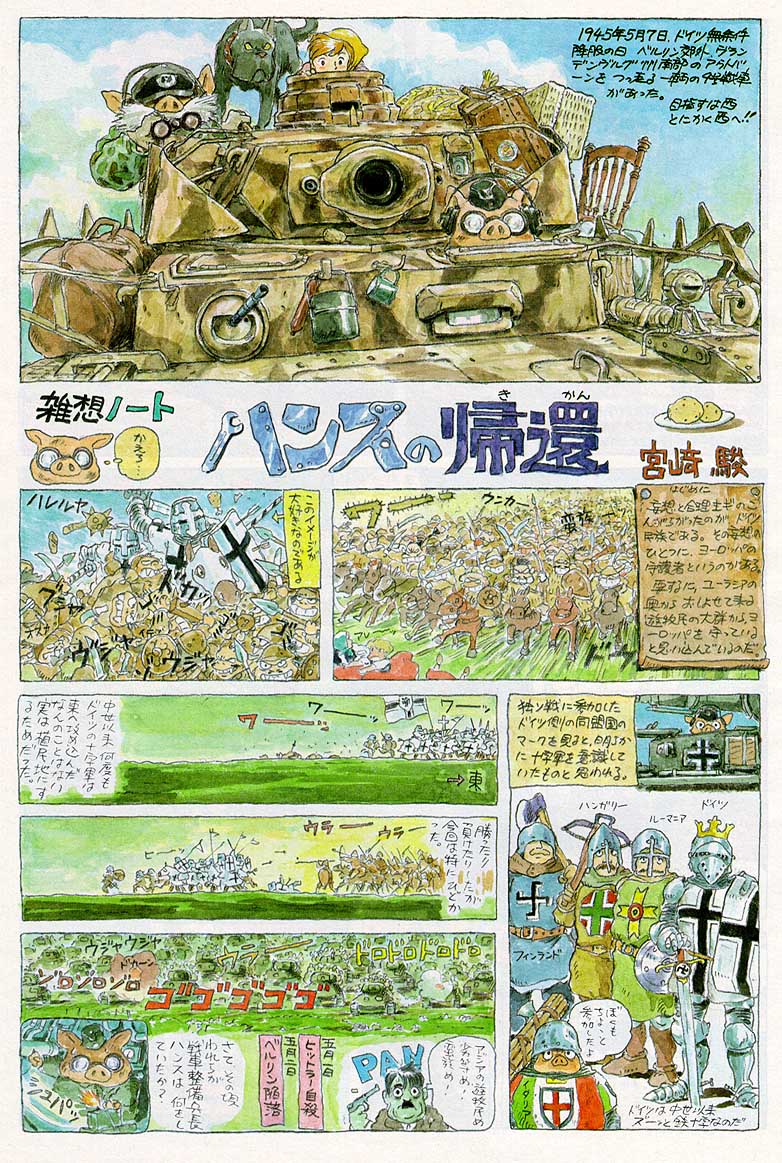
There’s links to these comics and many more in the Ghibli Wiki, but for fun here’s a link to the Wayback Machine version of that website that I remember from when I was a much younger nerd.
1:03:30 Wanna hear Michael Keaton as the lead from Porco Rosso yourself? Good news, you can!
1:04:30 Brad Garrett from two stupid dogs?
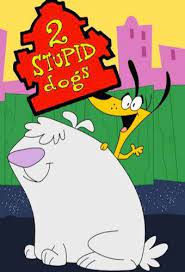
I had no idea who Brad Garrett was, and I just looked it up and he’s RAYMOND’S BROTHER FROM EVERYBODY LOVES RAYMOND. THAT WAS A VERY POPULAR SHOW, I’M TOLD. Probably more popular than 2 Stupid Dogs.

David, you are correct, that was a weird place to go to.
And as Deb says, that certainly was a place to end this week’s episode of Mangasplaining.
As a reminder, this episode is also available wherever you get your podcasts, so please subscribe and leave a review, so others can discover our show. If you’d like to get the latest episode delivered straight to your inbox along with exclusive interviews, articles and new chapters of manga you can’t read anywhere else, subscribe to our Substack newsletter. See what you’re missing at Mangasplaining Extra!
Next week on Mangasplaining:
Get ready for BLOOD BLOCKADE BATTLEFRONT vol. 1, by Yasuhiro Nightow! David’s hosting.
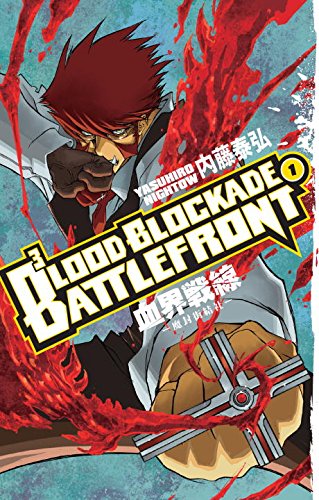
Thanks so much for listening! Please support your local comic and manga specialty shop when purchasing these books, and you can find one near you at comicshoplocator.com. You can also check your local library for print and digital lending options, they have TONS of manga! Finally, thanks to D.A.D.S. for their musical accompaniment for this episode.
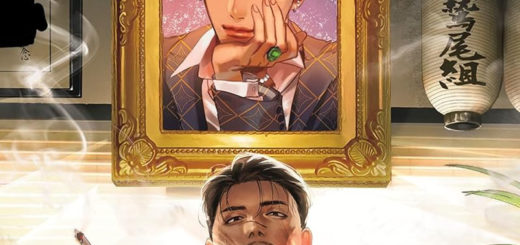
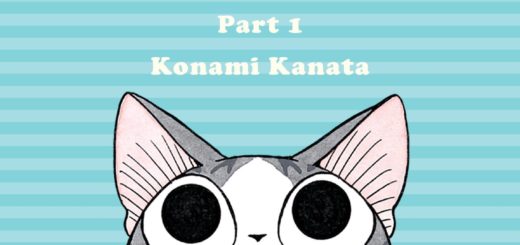
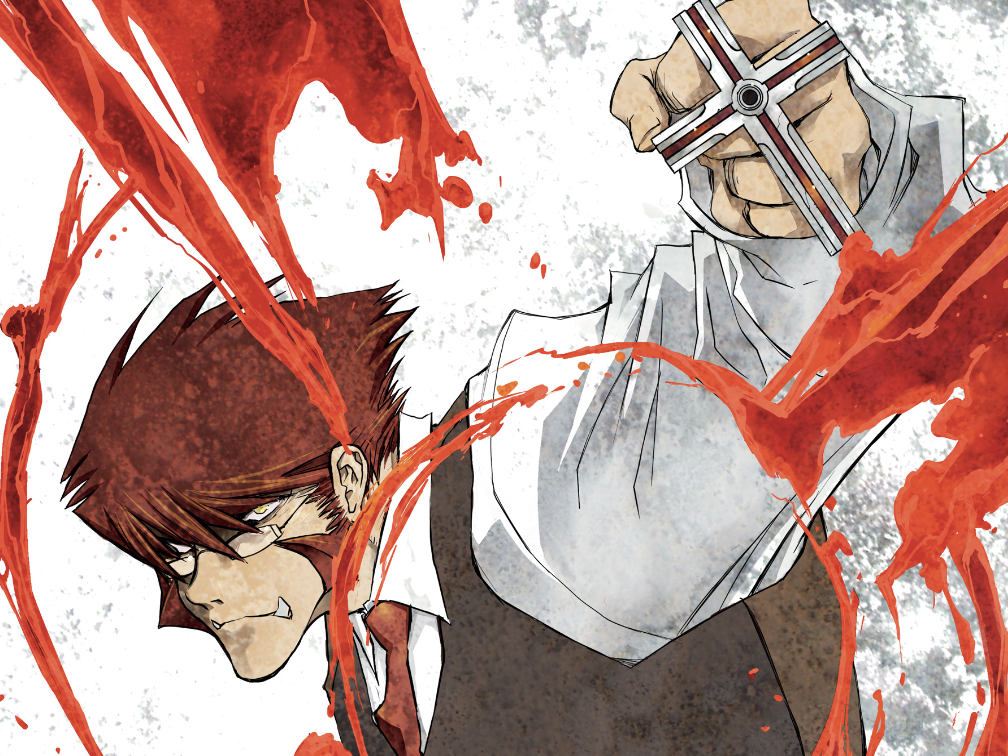
As a big fan of the remaining comic strips (Mary Worth has a new cos tenant! Judge Morgan has a new kidnapper!) I’m glad you guys came to Heathcliff.
As a bit Moto Hagio fanatic, I have to mention Moto Hagio’s Lil’ Leo, which Denpa released in a beautiful volume, Most of my fave shojo mangaka seem to have ended up writing stories about their cats… (which is something I can relate to.) https://denpa.pub/manga/lil-leo
Also-I had a subscription with Animerica when I was 12- Over my last move I got rid of a lot of the magazines (who’d thought my teen horniness was toRyoichi Ikegami)
I am glad I realized there was a reason to hang on to my three issues with Porco Rosso.